Microsoft NPC-1BG Single band, dual mode cellular telephone User Manual 3320ug v0 1 sw0 0
Microsoft Mobile Oy Single band, dual mode cellular telephone 3320ug v0 1 sw0 0
Exhibit 8 User Guide
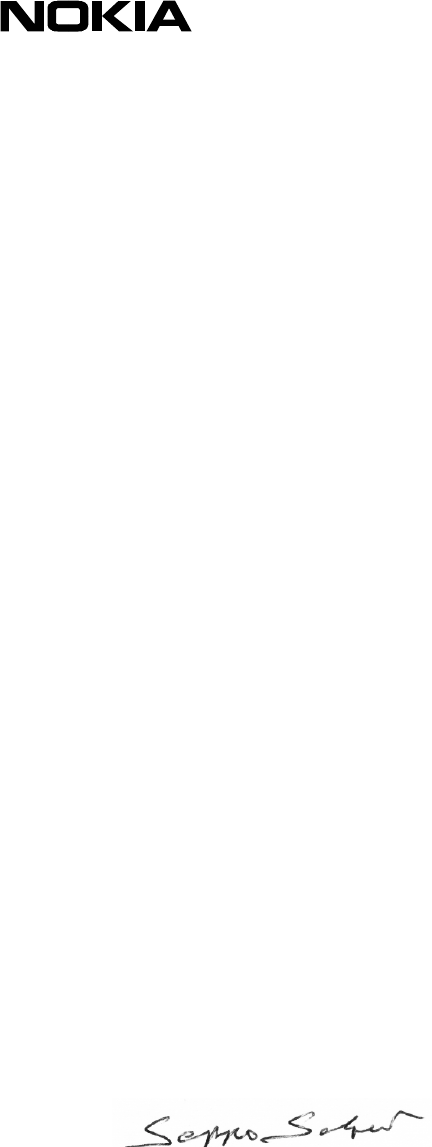
NOKIA MOBILE PHONES LTD
P.O.Box 50
FIN-90571 Oulu
FINLAND
Tel. +358 10 5051
Fax. +358 10 505 7222
April 26, 2001
Federal Communications Commission,
Authorization & Evaluation Division,
7435 Oakland Mills Road
Columbia, MD. 21046
Attention: Equipment Authorization Branch
For your convenience we have submitted a preliminary user guide of one of the LJONPC-1BG
variants with relevant changes in RF exposure measurement results. The user guide of
LJONPC-1BG will be available only in Portuguese. Except for the trade names, pictures of the
product and SAR values its’ content will be similar to this user guide.
NOKIA MOBILE PHONES
Seppo Salow
Product Program Manager, PC Site Oulu
[ 1 ]
Nokia 3320
User Guide
Draft V0.1
Not For Distribution

[ 2 ]
The wireless phone described in this guide is approved for use in TDMA
and AMPS networks.
Legal information
Part No. 9353391, Issue No. 1
© 2001 Nokia Inc. All rights reserved.
Nokia is a registered trademark of Nokia Corporation.
Printed in Canada XX/2001
Nokia, Nokia Connecting People and the Original Accessories logos are trademarks
of Nokia Corporation and/or its affiliates.
US Patent No 5818437 and other pending patents.
T9 text input software Copyright (C) 1999-2001. Tegic Communications, Inc.
All rights reserved.
Includes RSA BSAFE cryptographic or security protocol software from RSA
Security.
The information contained in this Owner’s Manual was written for Nokia
phone NPC-1 and NPW-1. The right to make changes and improvements to any of
the products described in this guide without prior notice is reserved.
Export Controls
This product may also be subject to United States export controls. The United
States export laws currently prohibit the export of certain technical data and
software into Cuba, Iran, Iraq, Libya, North Korea, Sudan, and Syria, or any national
or resident of those countries, or to anyone on the United States Treasury
Department’s list of Specially Designated Nationals or the U.S. Commerce
Department’s Table of Deny Orders. You agree that you shall not export this product
in contravention of United States export laws.
FCC/Industry Canada Notice
Your phone may cause TV or radio interference (for example, when using a
telephone in close proximity to receiving equipment). The FCC or Industry Canada
can require you to stop using your telephone if such interference cannot be
eliminated. If you require assistance, contact your local service facility.
This device complies with part 15 of the FCC rules. Operation is subject to the
condition that this device does not cause harmful interference.
[ 3 ]
[ 4 ]
Safety first 1
Safety guidelines 1
Road safety comes first 1
Switch off in hospitals 1
Switch off while aboard aircraft 1
Switch off when refueling 1
Switch off near blasting 1
Observe infrared precautions 1
Quick tips 2
Be aware of interference 2
Use your phone sensibly 2
Use only qualified service personnel 2
Use approved accessories and batteries 2
Read instructions before you connect to other de-
vices 2
Make sure the phone is on 2
Your phone’s label 3
Welcome 4
Get the most out of this guide 4
Understand the terms 4
Notice text conventions 4
Follow graphic clues 5
Look for updates 5
Understand wireless network services 6
Sign up with a service provider 6
Note differences among service providers 6
Learn about accessibility solution 6
[ 2 ]
The Nokia commitment 6
Alternate format user guides 7
LPS-3 Mobile Inductive Loopset 7
Find information about your phone 8
Contact Nokia 9
Have the right information available 9
Have the phone or accessory handy 9
Contact your service provider 10
Set up your phone 11
Attach the battery 11
Charge the battery 11
Remove the battery 12
Important battery information 12
Prolong battery life 12
Connect the headset 13
Use the carrying case 13
Adjust the volume 13
Adjust screen contrast 13
Choose the look of your screen 13
Review the basics 14
Antenna 14
Possible overheating 15
Learn the keys 15
Make and answer calls 16
Check the Start screen 16
Return to the Start screen 17
Check the header line and scroll bar 17
Review phone symbols 18
Use the selection keys 20
Check in-phone help 20
Browse phone menus 20
Scroll through menus 21
Use a shortcut 21
Shortcuts 22
Phone book menu 26
Use the phone book 28
Review ABC and 123 entries 28
Enter letters 28
Enter numbers 29
Enter punctuation and other characters 29
Use special characters in names and phone numbers
30 In ABC mode 30
In 123 mode 30
Check call history 31
Check the call log 31
Check missed calls 32
Check previously dialed calls 32
Check received calls 33
Clear call lists 33
Check call timers 34
Turn on a current call timer 34
Clear call timers 35
[ 4 ]
Use advanced calling features 36
Set in-call options 36
Use call waiting 37
Store the call waiting feature code 37
Activate call waiting 37
Manage calls 37
Make a conference call 37
Lookup a number during a conference call 38
Use call forwarding 39
Store the call forwarding feature code 39
Activate call forwarding 39
Redial automatically 41
Use a calling card 41
Save calling card information (step 2) 42
Choose a calling card to use 43
Make a calling card call 43
Send your own number in caller ID 43
Store the Send Own Number feature code 44
Select a phone number 45
Select the phone number 45
Select digital or analog 45
Set touch tones 46
Set touch tone length 46
Store touch tone sequences (strings) 47
Use voice mail 49
Check for messages 49
Set up your voice mailbox 49
Set greetings and passwords 50
Listen to your voice messages 50
Personalize rings & tones 51
What is a profile? 51
Select a different profile 51
Customize a profile 52
Set ring options 53
Set the ring volume 53
Set the ring tone 54
Set a vibrating alert 55
Set keypad tones 55
Set warning and game tones 55
Set the message alert tone 56
Set your phone to answer automatically 56
Set the lights (car kit only) 57
Rename profiles 58
Personalize phone settings 59
Set the display language 59
Set and display the clock 59
Set the clock 59
Display the clock 60
Select the time format 60
Add a welcome note 60
Use 1-touch dialing 61
Set up a 1-touch dial key 61
Change 1-touch dialing numbers 61
Erase 1-touch dialing numbers 62
[ 6 ]
Restore factory settings 62
Manage phone security 63
Change your security code 63
Protect your phone with the lock code 64
Turn on the phone lock 64
Store an unlocked phone number 65
Call an unlocked phone number 65
Answer a call while using a lock code 65
Change your lock code 65
Turn off the lock code 66
Lock the keypad 66
Activate keyguard 66
Deactivate keyguard 66
Answer a call while keyguard is active 67
Restrict calls 67
Restrict outgoing calls 67
Restrict incoming calls 68
Manage prepaid services 69
Activate the Prepaid menu 69
Deactivate the Prepaid menu 69
Save access phone numbers 70
Check the prepaid balance 70
Add money to your prepaid account 70
Check prepaid balances 71
Make calls using Prepaid service 71
Set network services features 72
Set up how your phone selects a system 72
Set up the way your phone selects a network 73
Switch between private and public systems 73
Select a public system 74
Use your phone on the road 75
Communicate with text messages 76
About text messages 76
Write with standard text entry 76
Write with predictive text 77
Keys and tools for predictive text 78
Turn on predictive text input 78
Turn off predictive text input 79
Tips for predictive text 79
Add a word to the match list 80
Insert numbers 80
Insert symbols 80
Write compound words 80
Use folders to store text messages 81
Write and send a text message 81
Save a message in the saved folder 82
Resend a message from the outbox 82
Receive a text message 82
Read a text message 83
Choose options for a message 83
When your phone’s memory is full 84
Erase a message 84
Reply to a message 85
[ 8 ]
Forward a message 85
Send and receive e-mail messages 85
Save e-mail addresses 85
Send an e-mail message 87
Other options for a completed message 88
Reply to or forward an e-mail message 88
Chat with other phone users 89
Use special features 90
Send and receive business cards 90
Send a business card 90
View a received business card 90
Save a viewed business card 90
Delete a viewed business card 91
Download ringing tones 91
Receive a ringing tone 91
Save a received ringing tone 91
Discard received ringing tones 92
Use the Alarm clock 92
Use the Calculator 93
Convert currency 94
Use Infrared 96
Sending and receiving data 96
Check the status of an IR connection 96
Other types of IR connections 97
Phone book 97
Reminders 98
Connect to the Internet* 99
Learn about the Services menu 99
Set up for browsing 100
Your service provider and WAP 100
Launch the browser* 100
Navigate a WAP card 100
The browser menu 101
The Options menu 102
Bookmarks 103
Download a ring tone 104
Play, save, or erase a ring tone 104
Play games 105
Start a new game 105
Snake II 105
Space Impact 105
Pairs II 105
Frequently asked questions (FAQ) 106
Glossary 110
Reference information 116
Batteries, chargers, accessories and Technical infor-
mation 116
Important safety information 117
Traffic safety 118
Operating environment 118
Electronic devices 118
Potentially explosive atmospheres 120
[ 10 ]
Vehicles 120
Emergency calls 121
Make an emergency call 121
Radio frequency (RF) signals 122
Care and maintenance 123
Accessories 124
Batteries 125
Charging times 125
Standby and talk times 126
Chargers and other accessories 126
When a charger is not in use 127
Standard Travel Charger (ACP-7) 127
Travel Charger (ACP-8) 127
Rapid Cigarette Lighter Charger (LCH-9) 127
Desktop Charging Stand (DCV-10) 128
Headset (HDE-2) 128
Nokia Xpress-on™ color covers 128
Troubleshooting 129
Technical Information 130
NOKIA One-Year Limited Warranty 132

[ 1 ]
1
1Safety first
Read these simple guidelines before you use your phone. Failure to comply
with these guidelines may be dangerous or illegal.
• SAFETY GUIDELINES
Following are important safety precautions for phone use.
Road safety comes first
Do not use a hand-held phone while driving. Park the vehicle first.
[road_saf]
Switch off in hospitals
Follow any regulations or rules. Switch your phone off near medical
equipment. [off_hosp]
Switch off while aboard aircraft
Wireless phones can cause interference. Using your phone aboard an
aircraft is illegal at certain times. Observe the rules as announced on the
aircraft. [off_airc]
Switch off when refueling
Do not use your phone at a refueling point. Do not use it near fuel or
chemicals. [off_refu]
Switch off near blasting
Do not use your phone where blasting is in progress. Observe restrictions,
and follow any regulations or rules. [off_blas]
Observe infrared precautions
Do not point the IR beam at anyone’s eyes or allow it to interfere with
other IR devices. [art]

[ 2 ]
1 • QUICK TIPS
Observe these brief guidelines to get the best performance from your
mobile phone.
Be aware of interference
All wireless phones may get interference that could affect performance.
[interfer]
Use your phone sensibly
Use your phone only in the normal position (next to the ear). Do not touch
the antenna unnecessarily.
[use_sens]
Use only qualified service personnel
Equipment must be installed or repaired only by qualified service
personnel. [qua_svc]
Use approved accessories and batteries
Use only approved accessories and batteries. Do not connect incompatible
products. [acc_batt]
Read instructions before you connect to other
devices
When you connect your phone to any other device, read the device’s user
guide for detailed safety instructions. Do not connect incompatible
products. Remember to make backup copies of all important data. [art]
Make sure the phone is on
Before you make a call, be sure your phone is switched on. To make and
receive calls, you must sign up with a cellular service provider.
[make_cal]

[ 3 ]
1
• YOUR PHONE’S LABEL
The label found on the back of your phone (under the battery) contains
important information about your phone, including the model and serial
numbers. You will be required to provide information from this label, in
the event you call Nokia Customer Service (or call your service provider).
Therefore, please do not remove or deface this label.

[ 4 ]
22Welcome
Congratulations on your purchase of a Nokia 3320 mobile phone, a new
tool for the mobile information society.
Nokia recommends that you read this chapter before you use your new
phone. You will find useful information about:
•How to use this guide
•Cellular network services
•How to contact Nokia
• GET THE MOST OUT OF THIS GUIDE
The tips that follow can help you get peak performance from this guide as
you learn to use your phone.
Understand the terms
This guide uses certain terms for certain actions.
Press means to briefly press and then release a key. For example,
press means press the zero key.
[Art for press menu] Press means to press the key that is below the
word Menu on the screen.
[Art for press menu] Press and hold means to press and hold a key for 1
to 3 seconds (depending on the feature you’re using), and then release the
key.
Notice text conventions
This user guide provides text “clues” to help make instructions clear and
easy to follow. These clues are called conventions.
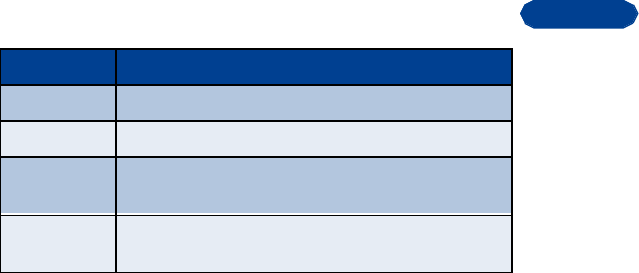
[ 5 ]
2
Follow graphic clues
This guide uses certain icons (small pictures) to alert you to important
information.
Tip: Provides information about a shortcut or an alternate method of
doing something.
Note: Explains a feature or points out an important concept.
Important: Alerts you to information critical to using a feature correctly.
Caution: Warns you when you may lose information.
Warning: Helps you avoid personal injury, damage to the phone, or
property damage.
Look for updates
From time to time, Nokia updates this user guide to reflect changes or
corrections. The latest version may be available at the Nokia site on the
World Wide Web: http://www.NokiaUSA.com
1On the home page, click Nokia Phones, scroll to the section about
your phone, and click Phone details.
2Click an item to download the user guide, quick guide, or interactive
guide (if available).
Convention What it means
bold The word or phrase appears on the phone’s screen.
bold and blue The word is an address on the World Wide Web.
bold, blue,
and italic A definition for the word or phrase appears in the terms
list near the end of the user guide.
italic Italics indicate emphasis. Pay close attention to any
information in italics.

[ 6 ]
2 • UNDERSTAND WIRELESS NETWORK SERVICES
A wireless network service provides the connections you need to use your
mobile phone. The network also can give you access to special wireless
services, including:
•Voice mail and voice privacy
•Call waiting, call forwarding, and caller ID
•Text and picture messages
•Ability to send your own number
•News and information services
•Selected Internet access services
Sign up with a service provider
Before you can take advantage of any of network services, you much sign
up with a wireless service provider. Your service provider will make
available descriptions of its services and instructions for their use.
Note differences among service providers
Wireless network providers differ from each other in certain ways. For
example, some networks may not support all language-dependent
characters. When you sign up for service, make sure your provider offers
the services you need.
• LEARN ABOUT ACCESSIBILITY SOLUTIONS
The Nokia commitment
Nokia is committed to making mobile phones easy to use for all
individuals, including those with disabilities. Nokia maintains a site on the
World Wide Web that is dedicated to accessibility solutions. For more
information about phone features, accessories, and other Nokia products
designed with your needs in mind, visit the Nokia World Wide Web site at
www.nokiaaccessibility.com.

[ 7 ]
2
Alternate format user guides
This user guide is available in alternate formats, including:
•Braille
•Large print
•Audiocassette
•E-text (3.5-inch disk in Microsoft Word or WordPerfect).
To request any format, call Nokia Customer Care at (888) 665-4228.
Hearing-impaired and other TTY users can contact Nokia at (800) 246-
6542.
LPS-3 Mobile Inductive Loopset
The LPS-3 Loopset is a Nokia accessory designed to make the 3300 series
phone more accessible to hearing-aid users. The LPS-3 Loopset is also
compatible with the Nokia 8200- and 8800- series digital phones.
The Nokia Loopset gives hearing-impaired wireless customers clear access
to digital telephony for the first time. With the Loopset, people who use
a T-coil equipped hearing aid can make and receive calls without noise
interference.
HOW THE LOOPSET WORKS
The LPS-3 Loopset uses inductive technology to
transmit sound to a hearing aid equipped with a
T-coil. With inductive technology, the sound
from the phone is amplified more efficiently and
background noise is eliminated.
The loopset is easy to use. You wear the loopset
around your neck, connect it to your phone, and
speak directly toward the microphone.
For detailed instructions on using the loopset, refer to the booklet that
comes with the LPS-3.
Note: The Loopset can be purchased separately as an accessory.

[ 8 ]
2Accessible features
The 3300 has many accessible features including:
•Nibs beneath the 5-key for quick reference to the keypad
•Tactile feedback when a key has been pressed
•Adjustable display contrast
•Adjustable font size
•Ability to send and receive short text messages
•Convenience of one-touch dialing
• Vibrating alert for incoming calls and messages
•Ability to define ring tones for different caller groups
• FIND INFORMATION ABOUT YOUR PHONE
If you ever need to call Nokia Customer Service or your cellular service
provider, you will need to provide specific information about your phone.
This information is provided on the phone’s label.
The label is on the back of the phone (under the battery). It shows the:
•Model number [Need picture of label]
•Phone type (a technical designation)
•Electronic serial number (ESN)
Do not remove or deface the label.
• CONTACT NOKIA
When you need help, the Nokia Customer Service department can provide
information about Nokia products.
Have the right information available
We recommend that you have the following information available before
you contact the Nokia Customer Service department:
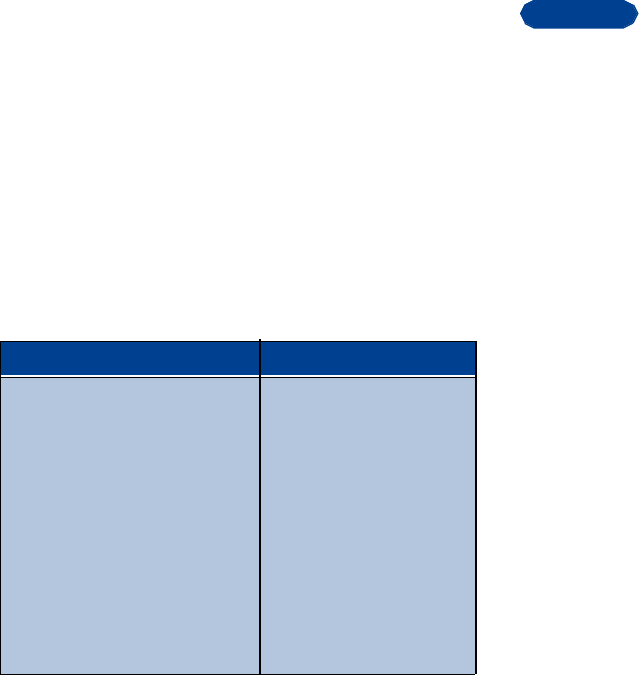
[ 9 ]
2
•The phone’s model number (3360)
•The ESN (serial number)
•Your ZIP code
The serial number is on the phone’s label. See “Find information about
your phone” for help.
Have the phone or accessory handy
Whether you’re calling your phone or an accessory, you should have the
the equipment with you when you call. For example, if you’re calling
about a headset, please have it handy. That way, if a Nokia representative
asks a specific question about the accessory, you will have it available for
quick reference.
Nokia Customer Care Center, USA Customer Service, Canada
Nokia Mobile Phones, Inc.
7725 Woodland Center Boulevard,
Suite #150
Tampa, Florida 33614
Tel: 1-888-NOKIA2U
(1-888-665-4228)
Fax: 1-813-249-9619
TTY: 1-800-24NOKIA
(1-800-246-6542)
Nokia Products Ltd.
575 Westney Rd. South
Ajax, Ontario L1S 4N7
Tel: 1-888-22NOKIA
(1-888-226-6542)
Fax: 1-905-427-1070

[ 10 ]
2Contact your service provider
Some service providers program a one-key customer support number into
the phone. This number can be useful if you’re having trouble dialing a
number, especially when you’re traveling outside your home area.
This one-key feature might not be available on all systems. Contact your
service provider for availability.
When you need to get in touch with your wireless service provider:
•Press and hold the <xxx> key (or the key that your service provider
instructed you to use) for 2 seconds.
Your phone will automatically dial the provider’s customer support
number.
If your service provider determines that the problem is Nokia-related,
their representative will direct you to the Nokia Customer Care Center
(USA) or Nokia Customer Service (Canada).

[ 11 ]
3
3Set up your phone
Before you use your phone, you need to:
•Charge the battery.
•Connect any accessories you want to use and set up for infrared
transfer.
•Adjust a few phone settings to suit your needs.
• ATTACH THE BATTERY
This section tells you how to install a new battery. If you’re installing a
replacement battery, make sure you use only a Nokia-approved part.
<Attaching/removing the battery - need to illustrate and get input
for the instructions>
1If the back cover is attached to your phone, carefully remove it. (See
Reference Information for instructions on removing the back cover. )
2Locate the metal connectors on the bottom edge of your battery.
3Holding the battery with the label facing you, place the battery in the
phone bottom first so that the connectors on the battery and the
connectors in the phone will be touching.
4Snap the top of the battery in so that the bar comes down snuggly
next to the battery.
• CHARGE THE BATTERY
Follow these guidelines to charge the battery.
1With your phone on or off, connect the lead from the charger to the
bottom of the phone.
2Connect the charger to an AC wall outlet.
The battery indicator bar starts to scroll up and down after a few

[ 12 ]
3seconds.
3Disconnect the charger from the phone and AC outlet when the
battery is fully charged.
After the indicator bar stops scrolling, the battery will accept a “trickle
charge” for an additional 2 hours until it is fully charged. See “Reference
Infromation” for more information on batteries.
• REMOVE THE BATTERY
You will need to remove the existing battery if you want to install a new
battery or if you’ve purchased a spare battery.
1Make sure the phone has been turned off for 10 seconds.
2Remove the back cover of the phone.
3Locate the battery latch that runs along the end of the battery
nearest the top of the phone.
4Using your thumbnails, press the bar away from the battery until it
snaps and the battery lifts slightly. Once the battery has lifted, you
can remove it from the phone.
Note: Use only your hands to remove the battery. Do not use any objects
which may damage the phone or the battery.
• IMPORTANT BATTERY INFORMATION
•Recharge your battery only with a charger approved by Nokia.
•You can switch the phone on and use it for calls while the battery is
charging.
•If the battery is totally empty, it may take a few minutes before the
charging indication appears on the screen.
•If the phone is switched on when charging is completed, the screen
momentarily shows the message Battery full.
•The BMC-2 battery does not need to be fully discharged before

[ 13 ]
3
recharging.
•Charging time depends on the charger and battery used. See
“Batteries” for charging times.
• PROLONG BATTERY LIFE
A NiMH battery lasts longer and performs better if you fully discharge it
from time to time. To discharge your battery, follow either of these steps.
•Leave your phone switched on until the battery is drained. Ignore any
messages to recharge your battery.
•Use the battery discharge feature of any approved accessory available
for your phone.
Important: Do not attempt to discharge the battery by any means other
than those just described.
• CONNECT THE HEADSET
• USE THE CARRYING CASE
• ADJUST THE VOLUME
• ADJUST SCREEN CONTRAST
• CHOOSE THE LOOK OF YOUR SCREEN
<personalize>

[ 14 ]
44Review the basics
This section gives you a brief introduction to the phone and shows quick
steps for making, answering, and managing your calls. The rest of this
guide provides complete details on phone use.
[keys picture of phone]
• ANTENNA
Your phone has a built-in antenna. As with any other radio transmitting
device, do not touch the antenna unnecessarily when the phone is
switched on. Contact with the antenna affects call quality and may cause
the phone to operate at a higher power level than otherwise needed.
[graphic of the back of the phone showing the antenna]
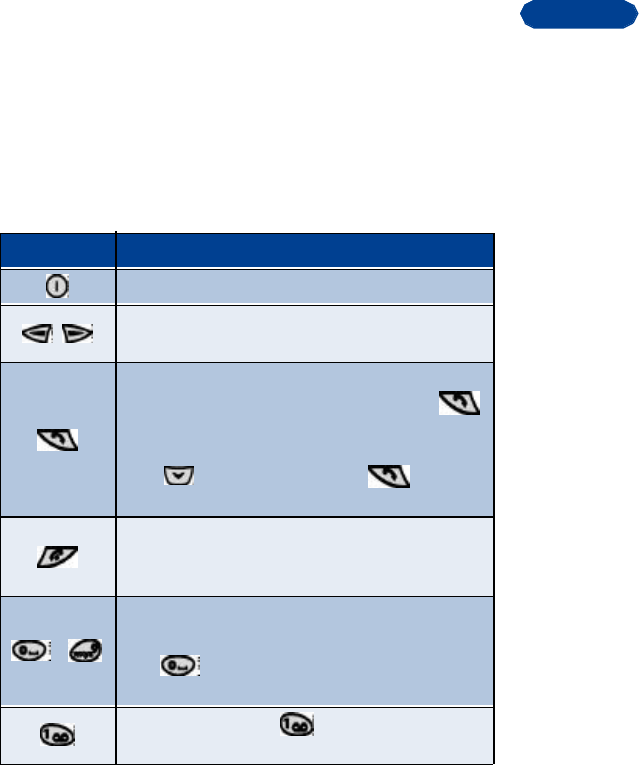
[ 15 ]
4
Possible overheating
It is normal for your phone to become hot during use. If the phone
becomes too hot, it automatically drops the current call and returns to the
Start screen. You won’t be able to make or receive calls until the phone
cools.
• LEARN THE KEYS
Here is a summary of how the various keys on your phone work.
Key What it does
Power: Press and hold to switch the phone on or off.
Selection: Press to choose the option shown by the
word above the key.
Talk: Press to make a call to the name or number
shown on the screen or to answer a call. Press
once at the Start screen to view the first in a list of
numbers you’ve most recently dialed.
Press to review the list. Press again to
call a number shown on the list.
End: Press to end a call or to silence the ring from an
incoming call. Also, press to return to the start
screen.
-
Number: Use keys 2 through 9 to enter numbers and
letters.
Press if you want to insert a blank space while
entering text.
1 Key: Press and hold to call your voice
mailbox.
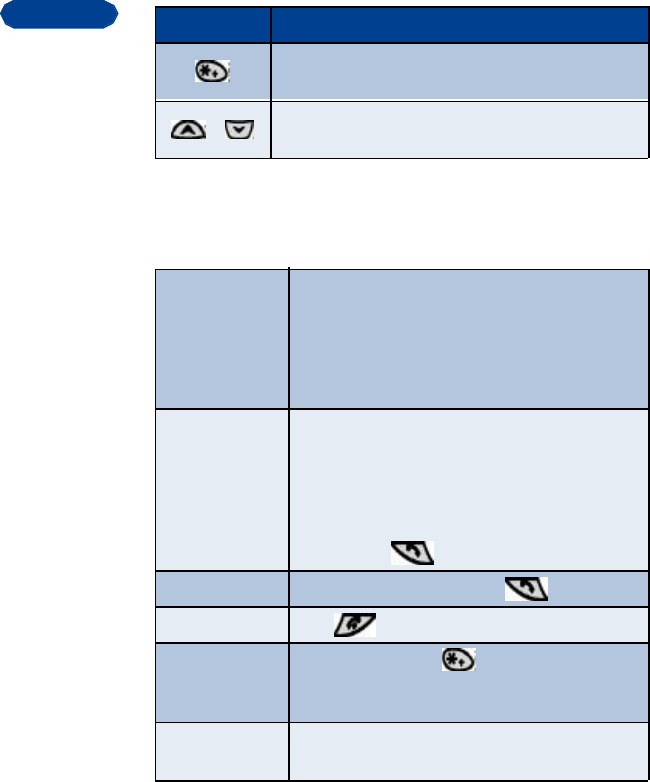
[ 16 ]
4
• MAKE AND ANSWER CALLS
Use this quick guide to make and answer calls.
Special characters: Press to enter special
characters, such as punctuation marks.
Scroll keys: Press to scroll up or down through a
menu list of options.
Switch the phone
on (or off) Press and hold the power key for 2 seconds.
Do not switch on the phone when wireless phone
use is prohibited or when the phone may cause
interference or danger.
[Warning graphic]
Make a call 1Hold the phone as you would any other
telephone, with the earpiece over your ear
and the microphone near your mouth.
2Press number keys to enter a number,
including area code if needed.
3Press .
Answer a call When your phone rings, press .
End a call Press .
Avoid
unintentional
calls
Press Menu and then . Keyguard is now set to
on. You cannot accidentally make a call.
Turn Keyguard
off Press Unlock and then OK.
Key What it does

[ 17 ]
4
• CHECK THE START SCREEN
When you switch on your phone, a Nokia welcome apears, and then you
see the Start screen. This is the “home base” for your phone.
The Start screen appears when the phone is “idling,” or standing by.
Return to the Start screen
You can easily return to the Start screen from any activity other than an
active call. To do so:
Press .
The phone clears any text or information you may have been entering, and
the screen returns to Start.
The phone erases any information you entered when you press .
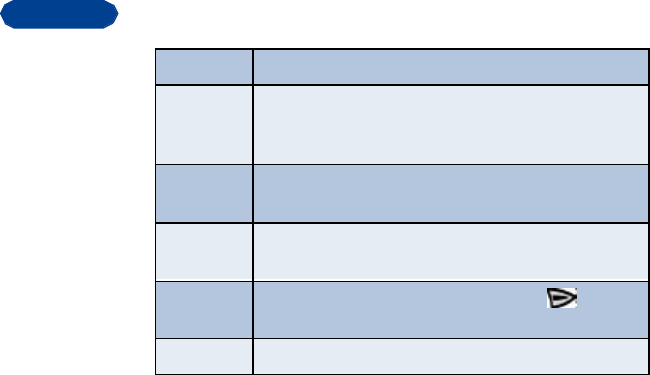
[ 18 ]
4ON THE START SCREEN
Check the header line and scroll bar
A header line appears at the top right corner of the screen when you’re
using the phone book or menus. This line reminds you of the phone book
entry or menu option with which you’re working.
A scroll bar appears on the right side of the screen when you scroll
through the main menus. The bar gives you a visual representation of your
relative position in the main menu structure. You cannot see the scroll bar
when you’re working with the phone book or once you have selected a
main menu item.
HOME Your service provider’s name may appear here.
Shows the signal strength of the wireless network
where you are. The higher the bar, the stronger the
signal.
Shows the battery charge level. The higher the bar, the
more power in the battery.
The top level of menu choices on your phone. Press
<xxx> to enter the menus.
The entry point for the phone book. Press to enter
the Names list (after you’ve added some entries).
Indicates that you are in a digital network.
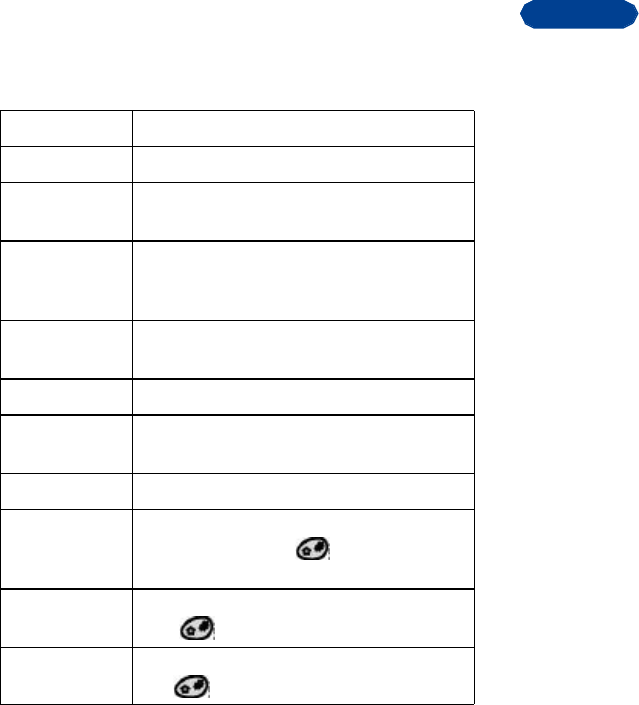
[ 19 ]
4
• REVIEW PHONE SYMBOLS
The following is a collection of the various symbols and signals you may
see on your phone.
Symbol What it means
You have an active call.
The phone is waiting for you to enter numbers
or text.
You have turned off your phone’s keypad tones,
warning tones, message alert tones, and set
your ringing tone to Silent.
You’ve activated Keyguard to help prevent any
accidental keypresses.
You have one or more voice messages waiting.
You have one or more unread text messages
waiting.
Digital service is available.
Alpha characters you enter will be uppercase
(capital letters). Press to switch to
lowercase.
Alpha characters you enter will be lowercase.
Press to switch to uppercase.
Characters you enter will be numbers. Press and
hold to switch back to letters.
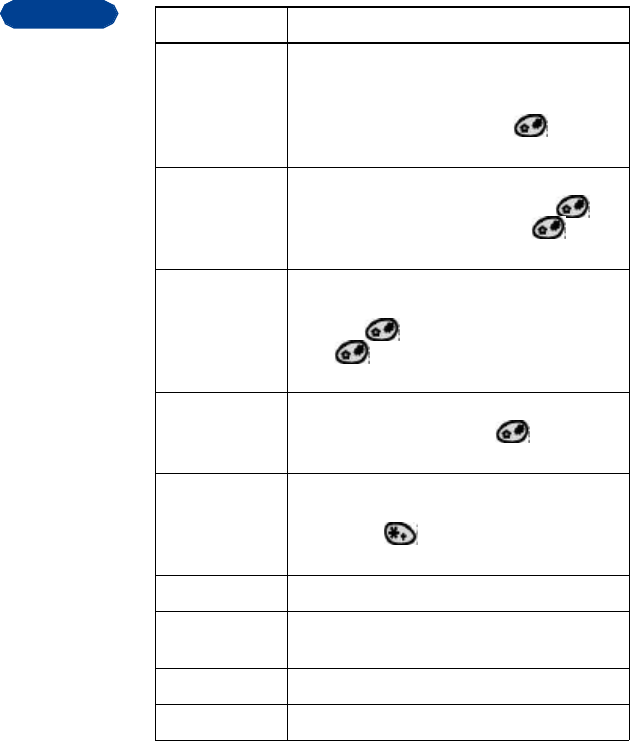
[ 20 ]
4
You are using predictive text. The first word of
every sentence will be uppercase. Available
when entering calendar notes, to-do list events,
or writing text messages. Press to switch
to numbers.
You are using predictive text. Characters you
enter will be uppercase letters. Press to
switch to lowercase letters. Press to
switch to numbers.
You are using predictive text. Characters you
enter will be lowercase letters (c, e, m, and so
on). Press to switch to uppercase letters.
Press to switch to numbers, or press and
hold the number you want until it apprears.
You are using predictive text. Characters you
enter will be numbers. Press to switch
back to letters.
You can enter only special characters, such as
punctuation marks. Appears when you press
and hold the key while entering or editing
text.
The alarm clock is set.
<Description of an on screen icon for
reminders?>.
You have an active data or <fax call?>.
Symbol What it means

[ 21 ]
4
• USE THE SELECTION KEYS
Note the two selection keys beneath the screen. What these keys do is
determined by the word shown above them on the screen.
•For example, pressing the left selection key when Menu appears
above it shows the first of many menus. You scroll through the menus
using the and keys.
•Pressing the right selection key when Names appears above it
opens the phone book menu.
When this guide says, “Press Menu,” it means, “Press the selection key
beneath the word Menu.”
• CHECK IN-PHONE HELP
Your phone provides brief descriptions of all menu options in an “in-
phone” help system.
1Scroll to a menu or submenu option.
2Wait about 10 seconds.
A short message appears, describing the option and what it does.
• BROWSE PHONE MENUS
A menu is a list of choices you can make to change settings on your phone
or use various phone features. Your phone has 12 menus.
Each menu can contain several levels of submenus. You can use menus
and submenus two ways: by scrolling or by using a shortcut.
Scroll through menus
Follow these steps.
1From the Start screen, press Menu, and then scroll through the menus
using the and keys.
2Press Options, Select, or OK, using the selection keys at the option

[ 22 ]
4you want.
3Use the scroll and selection keys to navigate the submenus and to
return to the Start screen.
Use a shortcut
Menus and options are numbered so that you can quickly key-press your
way to an option. The numbers appear in the top right corner of the screen
and show your location in the menu.
1Press Menu.
2Within 3 seconds, enter the first number of the menu function you
want to access. Repeat until you have entered all of the numbers.
Example: To turn on Automatic redial, press Menu 4 > 2 > 1 > 1
(Settings > Call settings> Automatic redial > On).
TIPS
•You can scroll upward (backward, so to speak) as well as downward
to find some of the most frequently used submenu options.
•You can return to the previous menu level by pressing Back.
•To exit a menu and return to the Start screen, press .
•You can always leave menu by pressing without changing the
menu settings.
Some menus may not appear. Ask your service provider for details.
• SHORTCUTS
1MESSAGES
1Write message
2Write e-mail
3Chat
4Inbox
5Outbox
6Archive
7Templates

[ 23 ]
4
8Erase all
9Voice messages
1Listen to voice messages
2Voice mailbox number
2CALL LOG
1Missed calls
2Received calls
3Dialed numbers
4Clear call lists
1All
2Missed
3Dialed
4Received
5Call duration
1Last call duration
2Dialed calls’ duration
3Received calls’ duration
4All calls’ duration
5Life timer
6Clear timers
3PROFILES
1General
1Activate
2Personalize
1Incoming call alert
2Ringing tone
3Ringing volume
4Vibrating alert
5Message alert tone
6Keypad tones
7Warning tones
3Rename <Not available with General>
2Silent
3Meeting
4Outdoor
5Pager

[ 24 ]
44SETTINGS
1Time settings
1Alarm clock
1On
2Off
2Clock
1Show/Hide clock
2Set the time
3Time format
3Auto update of date and time
1On
2Confirm first
3Off
2Call settings
1Automatic redial
1On
2Off
2Calling card
1None
2Card A
3Card B
4Card C
5Card D
3Current call
1On
2Off
3Phone settings
1Language (your phone may show other languages)
1American English
2Canadian French
3American Spanish
4Brazilian Portuguese
2Touch tones
1Manual touch tones
2Touch tone length
3Welcome note

[ 25 ]
4
4Help texts
1On
2Off
5Display contrast
6Power save if no service
3On
4Off
7Restore factory settings
4Accessory settings
1Headset
1Default profile
2Automatic answer
2Car/Handsfree
3Default profile
4Automatic answer
5Lights
3Loopset
1Loopset in use
2Default profile
5Security settings
1Call restrictions
1Restrict outgoing calls
2Restrict incoming calls
2Change security code
6Network services
1Public system selection
1Any system
2Home only
3Nonhome type
4Home type
2Digital/analog selection
1Digital & analog
2Analog
3Digital
3Voice privacy
1On
2Off

[ 26 ]
47Network feature setting
8Call forwarding (these options available only if the feature is turned
on; see your wireless service provider)
1Forward all calls
1Activate
2Cancel
2Forward if busy
1Activate
2Cancel
3Forward calls if not answered
1Activate
2Cancel
4Forward calls if out of reach or phone is off
1Activate
2Cancel
5Cancel all call forwarding
9Call waiting (these options available only if the feature is turned on;
see your wireless service provider)
1Activate
2Cancel
10 Own number sending
1Set by network
2On
3Off
11 NAM selection
5NETWORK SELECTION
1Automatic
2Manual
3New Search
6GAMES
1Snake 2
1Continue
2Last view
3New game

[ 27 ]
4
41 player
52 players
6Level
7Top score
8Instructions
2Space impact
3Pairs 2
4Settings
1 Sounds
1On
2Off
2Lights
1On
2Off
3Vibrator
1On
2Off
7CALCULATOR
8REMINDERS
9INFRARED
10 SERVICES
11 PREPAID
1Check balance
2Add money to account
3Save access phone numbers
12 NET MONITOR
• PHONE BOOK MENU
1For access to the phone book and its menus, switch back to the Start
screen.
2Press Names.
These options are available:
1SEARCH

[ 28 ]
42ADD ENTRY
3EDIT NAME
4ADD NUMBER
5ERASE
1One by one
2Erase all
6OPTIONS
1Type of view
1Name list
2Large font
3Name and number
2Memory status
7SPEED DIALING

[ 29 ]
5
5Use the phone book
The phone book gives you quick access to names, numbers, and e-mail
addresses.
•An entry in the phone book can consist of a number only, or a name
and a number.
•You cannot enter the same name twice. If you try to save a name that
is already in the phone book, the phone asks if you want to replace
the existing name.
• REVIEW ABC AND 123 ENTRIES
In the phone book, you enter names in what is called ABC mode and
numbers in 123 mode. The phone shows which mode is in use.
[ABC icon] [123 icon]
Enter letters
When you are in a name box in the phone book, the phone shows the ABC
icon. You use the phone’s keypad to enter letters. Here’s how:
1Find the key with the letter you want to enter.
2Press the key as many times as needed to get to the letter you want.
3Wait for the blinking cursor to reappear before you enter another
letter.
Example: Entering the name Albert
Press2 A
Press5 5 5 L
Press2 2 B
Press3 3 E
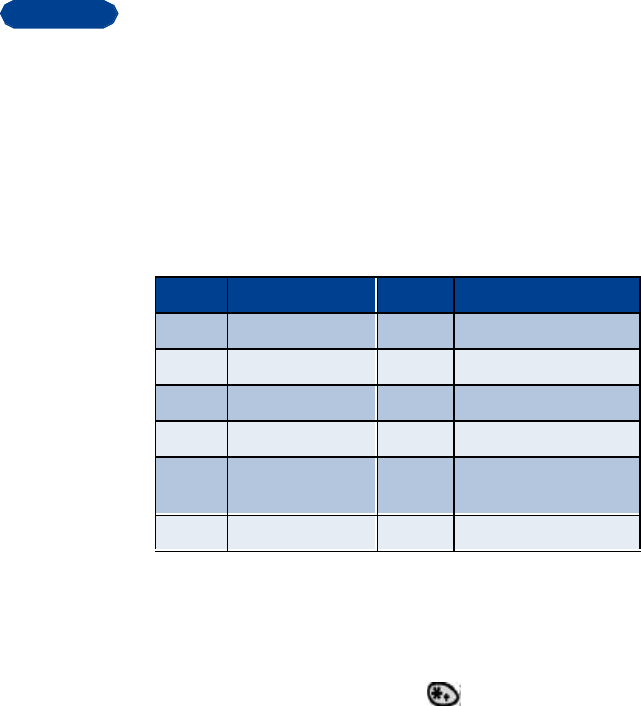
[ 30 ]
5Press7 7 7 R
Press8 T
Enter numbers
When you are in a number box in the phone book, the phone shows the
123 icon. [graphic]
•To enter numbers, simply press the numbers you want.
Enter punctuation and other characters
Depending on the language selected for your phone, the following
characters may be available:
[Graphic] Some networks may not support all language-dependent
characters.
ENTER SPACES AND PUNCTUATION
•To enter a space, press once.
•To enter punctuation marks, press . A screen appears with the
following special characters available:
. ? ! @ ‘ - _ ( ) , : ; & / ~ <hollow star> \ % * # + < = > “ <e symbol>
£ $ ¥ <circle with an X> § ¡ ¿
Key Characters Key Characters
1. , ‘ ? ! - 1 7P Q R S 7
2A B C 2 8T U V 8
3D E F 3 9W X Y Z 9
4G H I 4 0Space, 0
5J K L 5 *Special characters (See
XREF for details.
6M N O 6 #Changes letter case

[ 31 ]
5
Use the scroll keys to select the character you want, then press Use.
ERASE MISTAKES
If you make a mistake:
•Press to erase that character.
•Press Clear as needed to erase more than one character, or press and
hold to erase the entire field of characters.
CHANGE LETTER CASE
•To switch between uppercase and lowercase letters, press .
The ABC icon switches to abc, showing you are using lowercase letters.
• USE SPECIAL CHARACTERS IN NAMES AND PHONE
NUMBERS
In ABC mode
1Press and hold . A screen appears with the available special
characters.
2Use scroll keys to select the character you want, then press Select.
In 123 mode
The key inserts the following characters only in 123 mode:
•This character sends command strings to the network. Contact your
service provider for details. <This bullet needs to be a * symbol>
•This character is a prefix for dialing international numbers. <This
bullet needs to be a + symbol>
•This character creates a pause that occurs when dialing a number.
Numbers entered to the right of this special character are
automatically sent as touch tones after a 2.5-second pause. <Bullet
needs to be the letter p>
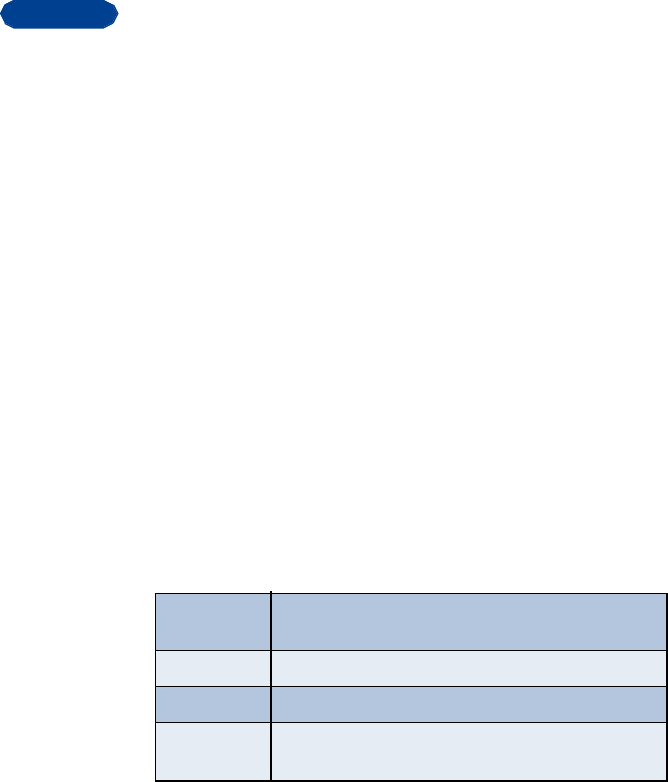
[ 32 ]
66Check call history
The call register keeps track of:
•Missed calls
•Numbers you’ve dialed
•Numbers from which you’ve received calls
•The amount of time you’ve spent on calls
• CHECK THE CALL LOG
Press Menu 2 to access Call log, then press Select.
The following submenus are available:
Missed calls
Received calls
Dialed calls
Clear call lists
Call timers
To select any of these options, press the Select key while the option is
displayed on the screen. The Missed calls, Received calls, and Dialed calls
menus include the following options (available when you press the
Options key):
Call time Shows the date and time when the call was
connected—if the clock has been set.
Send message
Edit number Allows you to edit the number shown on the screen.
Save Allows you to save the displayed number into your
phone book.
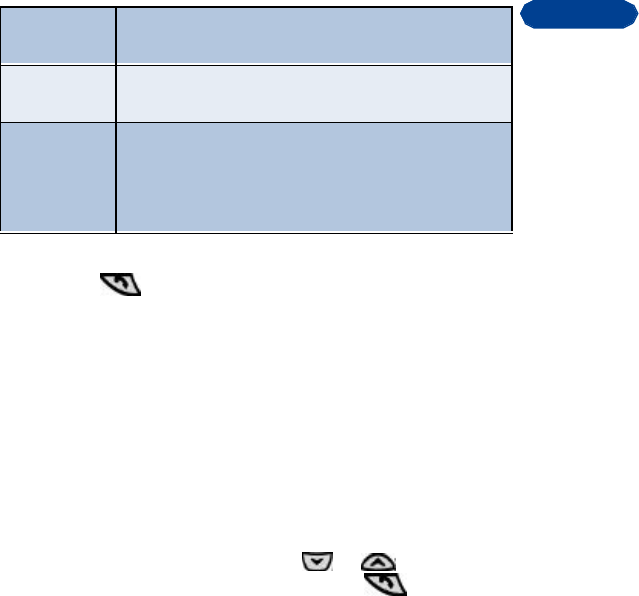
[ 33 ]
6
Tip: You can dial any numbers that appear on your phone’s screen by
pressing .
Check missed calls
Your phone stores up to the last 10 <?> numbers associated with calls you
have missed. When you miss a call(s), the message Missed calls appears
on your phone’s screen, along with the number of calls missed.
You are notified of missed calls only if your phone was turned on in the
original service area of your service provider.
To check missed calls:
1 Press List.
The phone shows the numbers of the calls you missed.
2Either scroll through the list using the or keys until you
reach a number that you want to dial and press , or press Back
to return to the Start screen.
If you prefer, you can press Menu 2 > 1 (Call log > Missed calls), then
scroll through the list of numbers.
Note: If you chose the Forward if not answered option in Call
Forwarding, then your phone treats these forwarded calls as
missed calls.
Add to name Add the number to an already existing name in your
phone book.
Erase Allows you to erase the displayed number from the call
log.
View number Allows you to view a number when an associated name
appears on the screen.
This option works only if you have stored the associated
number in the phone book.

[ 34 ]
6Check previously dialed calls
Your phone stores up to the last 10 numbers associated with calls that you
have dialed. To check this list of numbers:
1Press Menu 2 > 3 (Call log > Dialed numbers).
2Use or to scroll through the dialed numbers list.
3When you reach the number you want to dial, press .
You can also access previously dialed numbers by pressing and then
pressing or to scroll through the list.
Check received calls
Your phone stores up to the last 10 numbers associated with calls that you
have answered. To check this list of numbers:
1Press Menu 2 > 2 (Call log > Received calls).
2Use or to scroll through the list of received numbers.
3When you reach the number you want to dial, press .
Clear call lists
You can erase some or all of the numbers that appear in your phone’s call
register. You can erase dialed numbers, received call numbers, or missed
call numbers.
Warning: You cannot undo this operation.
To erase some or all of the numbers listed in your call registers:
1Press Menu 2 > 4 (Call log > Clear call lists).
2Use or to scroll through the options list, which includes
the following options: All, Missed, Dialed, and Received.
3Stop at the appropriate option and press OK.
Note: The All option clears every number in every list, whereas the other
options clear only the numbers associated with that option. For
example, the Dialed option clears only the numbers associated
with calls you previously dialed.
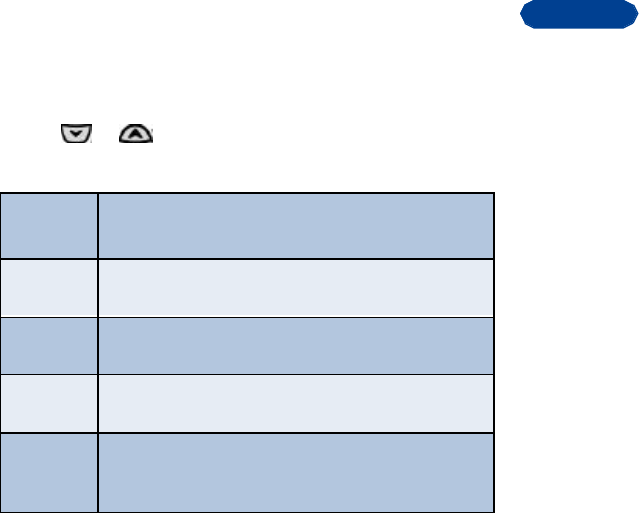
[ 35 ]
6
• CHECK CALL TIMERS
Your phone tracks the amount of time you spend on each call. To obtain
information about time spent on phone calls:
1Press Menu 2 > 5> 6 (Call log > Call duration > Call timers).
2Use or to scroll through the options described in the
following list:
Warning: If you select the Clear timers option, the action cannot be
undone. If you use the call timers to log the amount of time
spent on calls, you might want to record the information that
is in the call timers before you erase them.
Turn on a current call timer
You can set your phone to display the running elapsed time while a call is
active. To do so:
1Press Menu 4 > 2 > 3 (Settings > Call settings > Current call).
2Scroll to On and press
Last call
duration Shows the call duration of the last call made.
Dialed calls’
duration Shows the duration of all outgoing calls since you reset
the timers.
All calls’
duration Shows the call duration of all calls that have been made
and received since you reset the timers.
Life timer Shows the duration of all calls for the life of your
phone. This option cannot be reset.
Clear timers Clears all call timers for the currently selected phone
number. Your phone includes separate timers for each
number used, with the exception of the Life timer.

[ 36 ]
6From this point on, each call you make or receive will be timed. After a
call has ended, press any key on your phone to clear the current call’s
duration from the screen.
Clear call timers
1Press Menu 2 > 5 > 6 (Call log > Call duration > Clear timers).
The Security code field appears.
2Enter your security code and press OK.
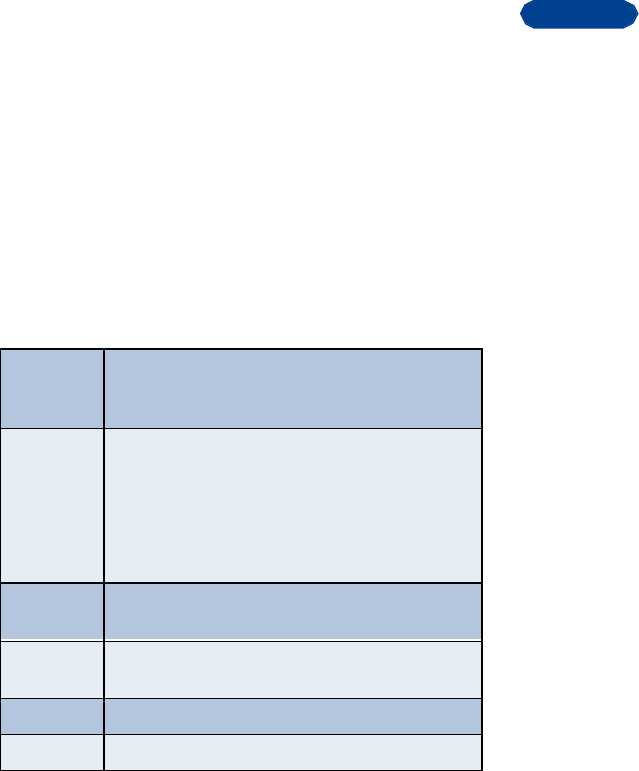
[ 37 ]
7
7Use advanced calling features
• SET IN-CALL OPTIONS
Your phone allows you to use a number of features during a call. These
features are known as in-call options.
Note: Many in-call options are network services features. To use these
options, you must contact your service provider.
You cannot use all these options at all times. This section tells you when
you can use a certain option.
1To access an option during a call, press Options.
2Choose from some or all of the following options:
Lock keys This option appears first only if your phone is
connected to a headset. Otherwise, the Mute option
(see next) appears first.
Mute Mutes the phone’s microphone. If, somehow, your
phone’s microphone has already been muted, End
mute appears instead of Mute. Press OK to choose
either of these options.
Note: These options can affect the microphones of
any accessories connected to the phone.
Touch tones Allows you to manually enter a touch tone string or
search for a string in your phone.
New call Allows you to “conference in” another call while you
are in the midst of a call.
Menu Allows you to access the Menu.
Names Allows you to access the phone book.

[ 38 ]
7 • USE CALL WAITING
If you have call waiting, your phone beeps during a call to let you know
that someone else is calling you.
Depending on your caller ID setup, the phone might also display the
number of the incoming call.
Note: Call waiting may not be available in all wireless systems.
Contact your service provider for details and availability.
Before you can use call waiting, you must contact your service provider to
make sure this feature is available and turned on for your phone.
Then you must activate the call waiting feature.
Store the call waiting feature code
Activate call waiting
1Press Menu 4 > 9 > 1 (Settings > Call waiting > Activate).
2 Press OK.
Your phone calls the network to confirm the feature code you entered.
After the network confirms the feature code, call waiting is activated.
• MANAGE CALLS
Call waiting works with both local and long distance calls.
•To answer an incoming call, press .
•To switch from one call to another, press .
•To end both calls, press .

[ 39 ]
7
Make a conference call
While in a call, you can call another number and “conference in” (add) a
third party to the call.
The conference call feature varies based on wireless systems. Contact your
service provider for details.
1While in a call, you can either dial the number you want to conference
in and press <?>.
OR
You can press Options, scroll to New call, press OK, enter the phone
number, and press OK again.
If you don’t remember the number of the party you want to include in the
conference, and you know that this number is in your phone book, you can
recall the number.
2When the third party answers, press <?> to connect all three parties.
Note: To place one of the parties on hold, press [graphic] again. If you
press [graphic] a third time, the party you placed on hold rejoins
the call, and the second party is placed on hold. Once you place
one of the parties on hold, you are unable to rejoin all three
parties.
3To drop all parties, press .
Lookup a number during a conference call
If you don’t remember a number that you need to call while in another
call, and you know that this number is in your phone book, you can recall
the number without having to quit your current call.
1During the call, press Options.
2Scroll to Names and press OK.
3Press Select at Search.
4Enter a name and press OK, or scroll through the phone book.
5Press [graphic].

[ 40 ]
7 • USE CALL FORWARDING
With call forwarding, you can forward incoming calls to another number.
This way, if you are unable to receive calls on your phone, all calls going
to that phone can be forwarded to another phone. You never have to miss
an important call.
Note: The call forwarding feature might not be available in all wireless
systems. Contact your service provider for details and availability.
Before you can use call forwarding, you must first store its feature code.
Then you must activate the call forwarding feature.
You can use the call forwarding feature code manually as opposed to
storing it. Each time you need to forward phone calls, you must enter the
feature code before the phone number (for example, *72 555 1212).
Store the call forwarding feature code
1Press Menu 4 > 7 (Settings > Network feature setting).
The Feature code field appears.
2Enter the feature code your service provider gave you and press OK.
3Use or to scroll to Call forwarding and press Select.
Activate call forwarding
1Press Menu 4 > 8 > 1 (Settings > Call forwarding).
2Scroll to the desired call forwarding option, as described in the
following table, and press Select.
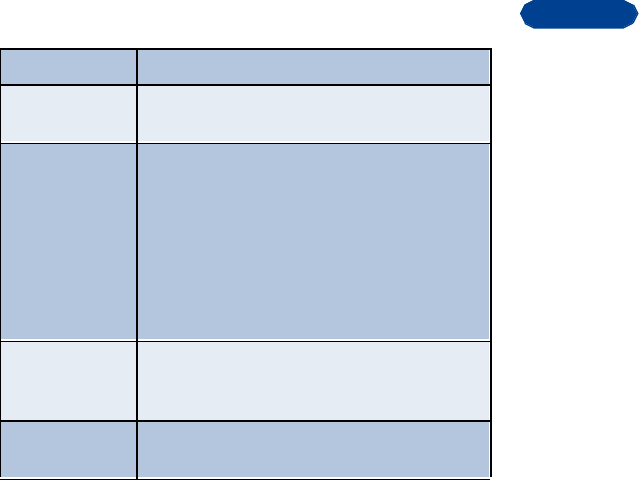
[ 41 ]
7
3Highlight Activate and press OK.
4At the Number field, either enter the number to which you want your
calls forwarded or press Search to find this number in the phone book
(if you have stored the number in the phone book).
5Press OK.
Your phone calls the network to confirm the feature code that you
entered in Menu 4 > 7. After the network confirms the feature code, call
forwarding is activated.
Forward all calls Forwards all incoming calls.
Forward if busy Forwards calls only when you’re on your phone
and do not have voice mail.
Forward calls if
not answered Forwards calls if you don’t answer. This option is
handy if you want to give your phone to someone
for a short period of time, but you don’t want
them to answer the phone.
For example, you could use this option if you give
your child the phone to take out, in case of an
emergency, but you still want to receive any
incoming calls made to this phone.
Forward calls if
out of reach or
phone is off
Forwards calls if you are out of the serving
wireless network, or if your phone is turned off.
Cancel all call
forwarding Cancels all forwarding options that are currently
active.

[ 42 ]
7 • REDIAL AUTOMATICALLY
Automatic redial enables your phone to continue trying to call a number
that was busy due to wireless network problems.
When you call a number and get a busy signal because of network
problems, your phone redials this number up to <3?> times. If you want
to stop this process prior to the last attempt, press [graphic]. This stops
the automatic redialing.
Before you can use the Automatic Redial feature, you must activate it.
1Press Menu 4 > 2 > 1 (Settings > Call settings > Automatic redial).
2Scroll to On.
3Press OK.
• USE A CALLING CARD
You can use a calling card when you dial long distance calls. First you
must store your calling card information in the phone. Your phone can
store information for a maximum of four calling cards.
Save calling card information (step 1)
1Press Menu 4 > 2 > 2 (Settings > Call settings > Calling card).
2Scroll to card A, B, C, or D and press Options.
3Scroll to Edit and press OK.
The Security code field appears.
4Enter your security code and press OK.
The Dialing sequence field appears.
5Press Select.
6Use or [down] to scroll through the list of dialing sequences, as
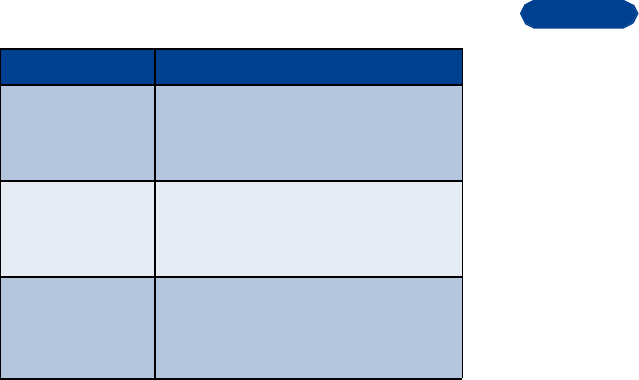
[ 43 ]
7
described in the following table.
7Press Select.
Save calling card information (step 2)
The order of the following steps may vary, depending on which dialing
sequence your card uses.
1When prompted for the calling card’s access number, enter the
number and press OK.
This number is usually the 1-800 number that is listed on the calling
card.
2When prompted to enter a calling card number (usually shown on the
front of the calling card) and PIN number, enter the number, and press
OK.
3Press OK again when the Save changes? message appears.
4Use [graphic] or [graphic] to scroll to Card name, press Select, and
enter the card name using your phone’s keypad.
Dialing sequence Use for cards that require you to
Access no.
+ phone no.
+ card no.
Dial 1-800 access number, then phone
number, then card number (+ PIN if
required).
Access no.
+ card no.
+ phone no.
Dial 1-800 access number, then card
number (+ PIN if required), then phone
number.
Prefix
+ phone no.
+ card no.
Dial the prefix (any numbers that must
precede the phone number) and phone
number you want to dial, then card
number (+ PIN, if required).

[ 44 ]
75Press OK.
Choose a calling card to use
If you have more than one calling card, you’ll need to choose one before
making a call.
1Press Menu 4 > 2 > 2 (Settings > Call settings > Calling card).
2Scroll to the desired card and press Options.
3Press [graphic] or to highlight Select and press OK.
The Security code field appears.
4Enter your security code and press OK.
The message Card ready for use appears.
Make a calling card call
To make a calling card call:
1Enter the phone number, including any prefix (such as 0 or 1) your
calling card might require when you make a calling card call. See your
calling card for instructions.
2Press and hold until your phone displays the message Card call, then
Wait for tone and press OK again.
3When you hear the tone from your calling card service, press OK.
Note: This procedure might not apply to all the calling card options that
are programmed into your phone. Check your calling card for more
information, or contact your long distance company.
• SEND YOUR OWN NUMBER IN CALLER ID
You can determine, for each call you make, whether your telephone
number appears on another phone’s caller ID.
In most service areas, when you call others, your name is presented to
their caller ID (if they subscribe). With Send Own Number, you can block
or send the display of your number when you make a call.

[ 45 ]
7
Note: Send Own Number might not be available in all wireless systems.
Contact your service provider for details and availability. Also note
that this feature is effective only when you call a number that is
equipped with caller ID.
Before you can use Send Own Number, you must first store its feature
code. Otherwise, this feature might not appear on your phone’s menu.
Store the Send Own Number feature code
1Press Menu 4 > 10 > 1 (Settings > Own number sending > Set by
network).
The Feature code field appears.
2Enter the feature code your service provider gave you and press OK.
3Use [graphic] or to scroll to Send own number and press
Select.
Your phone calls the network to confirm the feature code that you
entered in Menu 4 > 10 > 1. After the network confirms the feature code,
Send Own Number is activated.
Set whether or not your number will appear
1Press Menu 4 > 10 (Settings > Own number sending).
2Scroll to On (to show your number) or Off (not to show it).
3Press OK.
4Enter the number you wish to call (or press Search to retrieve the
number from the phone book), and press OK.

[ 46 ]
7 • SELECT A PHONE NUMBER
Your service provider programs, into your phone’s memory, its phone
number and system information when you first activate your phone. The
number assigned to your phone provides service for only one service area.
However, your phone can be activated in up to three different service
areas. For example, your phone could be activated in Dallas, Chicago,
and New York. Each service area would assign a different phone number
or account to your phone.
You must select a phone number for your home system, and if you travel
outside your home system, you can choose another number.
Only one phone number can be active at a time.
Note: It might not be necessary to have up to three numbers for your
phone if your service provider has service or roaming agreements
for each area in which you wish to use your phone. Contact your
service provider for details.
Select the phone number
1Press Menu 4 > 11 (Settings > NAM selection).
2Scroll to the phone number you want to use and press OK.
Note: The first phone number on this list is the currently selected
number. You need at least one active number to make calls.
Select digital or analog
Your phone can work in both digital and analog modes. The default mode
is both digital and analog, which appears on your phone as Digital &
analog when you press Menu 4 > 6 > 2 (Settings > Network services >
Digital / analog selection).
The menu options for choosing the mode you prefer are:
•Digital & analog
•Analog
•Digital
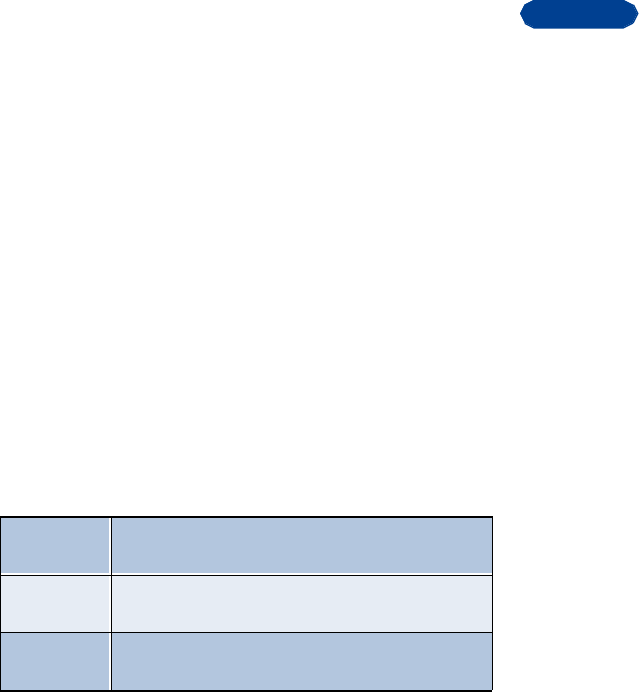
[ 47 ]
7
Note: This feature is available only for certain phones. Contact your
service provider for more information.
This means that your phone uses both digital and analog voice channels.
The phone always tries to find a digital voice channel first, but if a digital
voice channel is not available, the phone looks for an analog voice
channel.
• SET TOUCH TONES
Touch tones are sounds that are produced when you press the keys on
your phone’s keypad. Sometimes, touch tones are called DTMF tones, but
this guide calls them touch tones.
You can use touch tones for many automated over-the-phone services
such as checking bank balances and airline schedules and using your voice
mailbox. Touch tones can be sent only when a call is active.
Set manual touch tones
1Press Menu 4 > 3 > 2 > 1 (Settings > Phone settings > Touch tones
> Manual touch tones).
2Select one of the following options, then press OK:
Set touch tone length
You can also set the length of each touch tone. To do this:
Continuous The tone sounds for as long as you press and hold a
key.
Fixed Sets the tone length to 0.1 second, regardless of how
long you press a key.
Off Turns off the tones. No tones are sent when you press
a key.

[ 48 ]
71Press Menu 4 > 3 > 2 > 2 (Settings > Phone settings > Touch
tones > Touch tone length).
2Use or to scroll to Short or Long. Short sets the tone
length to .1 second.
3
4.
5
6.Long sets the tone length to .5 second.
7Press OK.
Store touch tone sequences (strings)
You store touch tone strings the same way that you store names and
numbers in your phone book. You can store an entire digit sequence and
send it as touch tones for frequently used strings of numbers.
STORE TOUCH TONE STRINGS WITH PHONE NUMBERS
1Enter the phone number that you want associated with a touch tone.
2Press w or p where needed.
w (wait): When you dial this phone number, your phone first dials the
number, then waits (because of the w character) for you to press
Send. When you press Send, the phone sends your touch tone.
p (pause): If you include a p character instead of a w, your phone
pauses for 2.5 seconds, then automatically sends your touch tone.
3Enter the touch tone string.
4Store the number as you normally would.
SEND A TOUCH TONE STRING
1Press Menu 4 > 3 > 2 > 1 (Settings > Phone settings > Touch tones
> Manual touch tones).
2Make sure that the setting is not set to Off.
If it is, use or to scroll to one of the other options and

[ 49 ]
7
press OK.
3Then, during your call, press Options, scroll to Touch tones and
press OK.
4Enter the touch tone string or recall the string from the phone book,
and press OK.
Warning: If you send touch tones while in the analog mode, be careful
not to send confidential information.

[ 50 ]
88Use voice mail
Voice mail is a network services feature. Colleagues who miss you when
they call can leave a voice message, which you can retrieve later.
• CHECK FOR MESSAGES
•Your phone beeps when you receive a voice message. Also, the
message New voice message appears on your phone’s screen, along
with the [graphic] icon.
•If you have received more than one voice mail message, depending on
your wireless network your phone may display the number of
messages that you have received.
Note: To use voice mail, you need to learn the voice mail system’s various
greetings, passwords, and prompts. Your service provider can
provide instructions.
• SET UP YOUR VOICE MAILBOX
As part of your network’s voice mail feature, your service provider gives
you a voice mailbox phone number. Save this number in your phone to
make getting your voice messages quick and convenient.
1Press Menu 1 > 9 > 2 (Messages > Voice messages > Voice mailbox
number).
2Enter your voice mailbox phone number.
3Press OK.
•Press Yes if you want to save a hidden voice mailbox password in
your phone.
•Press No if you don’t.
4If you selected Yes, enter your security code.
5Press OK.

[ 51 ]
8
6Enter your voice mailbox password and press OK.
Your voice mailbox number can be up to 32 digits long and is used until
it’s changed. Therefore, if your phone number changes, you may need to
change your voice mailbox number along with it.
• SET GREETINGS AND PASSWORDS
These may vary in different wireless systems. If you need information
about how to record your greeting or how to store your password, contact
your service provider.
Note: If you store your voice mailbox password in your phone, the phone
immediately sends the password after you dial your voice mailbox
number.
• LISTEN TO YOUR VOICE MESSAGES
Note: The way you listen to your voice messages may vary depending
upon your service provider. Call your service provider if you have
any questions.
1When your phone alerts you to new voice messages, press Listen and
follow the instructions given on the phone.
2If you’d rather listen to your messages later, press Exit.
3To listen to your voice messages at a later time:
Press and hold .
OR
Press Menu 1 > 9 > 1 (Messages > Voice messages > Listen to voice
messages).
The message Calling voice mailbox appears on the screen. Follow the
prompts to access your messages.

[ 52 ]
99Personalize rings & tones
• WHAT IS A PROFILE?
A profile is a “set of settings” you can use to customize the way your
phone works. You can set your own preferences for these items:
Ringing options
Ringing volume
Ringing tone
Vibrating alert
Keypad tones
Warning & game tones
Message alert tone
Your phone comes with seven profiles:
Normal (default setting)
Silent
Meeting
Outdoor
Pager
Car
Headset
You can customize any of the profiles. If at any time you want to return
to the original settings, you can do so.
• SELECT A DIFFERENT PROFILE
1Quickly press the Power key.
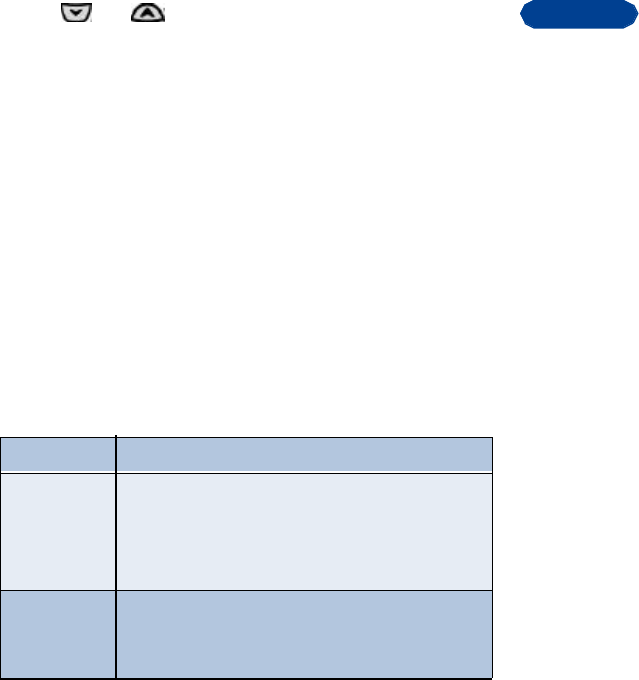
[ 53 ]
9
2Use and to move to the profile you want to use.
Profile names are highlighted (selected) as you scroll through them.
3Press OK to select a profile.
Note: To select a different profile, your phone cannot be connected to a
car kit or a headset, and your phone must be at the Start screen.
• CUSTOMIZE A PROFILE
1Press Menu 3 (Profiles).
2Scroll to the desired profile in the list.
Note: The Car and Headset profiles do not appear unless
your phone is connected to these accessories. If you connect your
phone to a car kit or to a headset, these profiles remain in the
menu, unless you choose to restore your phone’s factory settings.
3Press Options to view the options for the selected profile.
4Select one of the following options, then press OK.
Note: When you change a setting in the current profile, it affects only
that profile. Your phone’s normal settings do not change.
Select Activates the currently highlighted profile.
Customize Enables you to customize a profile by changing the
current settings.
•Press OK to choose from several lists.
Rename Enables you to rename the profile.
This option does not appear in the Normal, Headset,
or Car kit profiles.
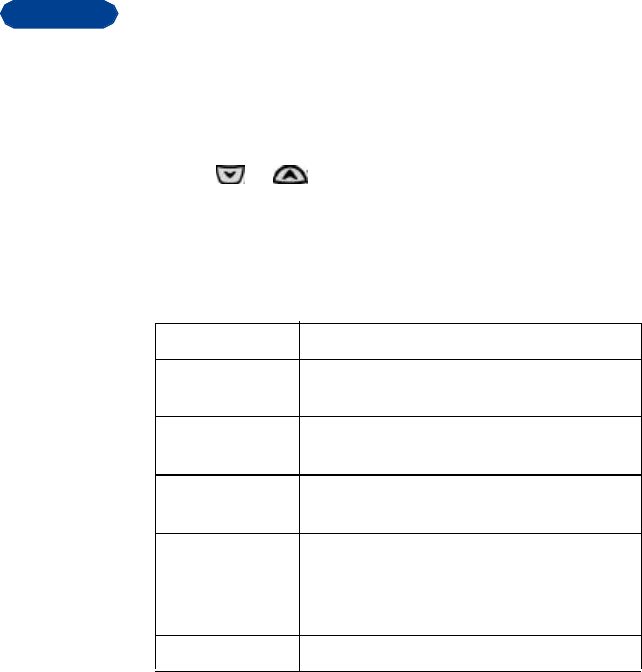
[ 54 ]
9Set ring options
You can choose the tone that your phone uses to notify you of an
incoming call. This setting does not affect any incoming text message
alert tones.
1Press Menu 3 (Profiles).
Your phone lists each profile.
2Use or to scroll to the desired profile in the list for which
you want to set the ringing options, and press Options.
3Select Customize and press OK.
4Scroll to Ringing options and press Select.
5Scroll to one of the ringing options, as described below, and press OK.
Set the ring volume
You can set the default ringing volume for incoming voice calls and
message alert tones.
Ring The phone rings until it is answered.
Ascending Ringing volume increases (gets louder) if the
phone is not answered.
Ring once The phone rings once to indicate an incoming
call.
Beep once The phone beeps once to indicate an incoming
call.
Caller groups <?> Sets the ring to a silent ring, unless a call comes
from a number within a caller group. Use or to
scroll to the desired caller group(s), then press
Mark to select or Unmark to deselect them.
Silent The phone makes no sound.

[ 55 ]
9
1Press Menu 3 (Profiles).
2Use or to scroll to the profile for which you want to set
the ringing volume, and press Options.
3Highlight Customize and press OK.
4Scroll to Ringing volume and press Select.
5Scroll through the options. When you hear the volume level you wish
to use, press OK.
Note: As you scroll through the ringing options, you can listen to a
sample of each. Although the ringing sample for level 4 and level
5 are the same, ringing level 5 will produce very loud ringing.
The ringing volume setting is stored individually for the handsfree car kit
and the headset.
Set the ring tone
You can set your phone’s ringing tone to a specific sound—or tune—for
incoming voice calls.
Note: If you have already chosen a ringing option of either Silent or
Beep once (Set ring options XREF), the ringing tones are already
turned off.
1Press Menu 3 (Profiles).
Your phone lists each profile.
2Use or to scroll to the profile for which you want to set
the ringing tones.
3Press Options.
4Scroll to Customize and press OK.
5Scroll to Ringing tone and press Select.
6Scroll through the options, and, when you hear the tone you want to
use, press OK.

[ 56 ]
9Set a vibrating alert
Instead of choosing to have your phone ring, you can have it vibrate to
indicate an incoming call.
1Press Menu 3 (Profiles).
2Use or to scroll to the profile for which you want to set
the vibrating alert, and press Options.
3Select Customize and press OK.
4Scroll to Vibrating alert and press Select again.
5Use [graphic] or to scroll to On and press OK.
The phone does not vibrate when it is connected to or placed in any
charging device.
Set keypad tones
Keypad tones set the volume of the tone you hear when you press your
phone’s keys.
1Press Menu 3 (Profiles).
2Use or to scroll to the profile for which you want to set
the keypad tones, and press Options.
3Select Customize and press OK.
4Scroll to Keypad tones and press Select.
5Use or to scroll to one of the levels and press OK. (If you
choose Off, no keypad tones are heard.)
If you chose the Silent profile in step 2, the keypad tones are turned off.
Set warning and game tones
You can set warning tones and the tones used for the games in your
phone.
Warning tones include the sounds your phone makes during error
conditions, during confirmations, when a battery is low, and when you
need to recharge the battery.

[ 57 ]
9
1Press Menu 3 (Profiles).
2Use or to scroll to the profile for which you want to set
the warning tones, and press Options.
3Select Customize and press OK.
4Scroll to Warning and game tones, then press Select.
5Scroll to On and press OK.
If you do not want to use warning or game tones, you can turn them off
by scrolling to Off and pressing OK.
Set the message alert tone
You can set your phone to use a certain tone to indicate an incoming text
message.
1Press Menu 3 (Profiles).
2Use or to scroll to the profile for which you want to set
the message alert tone, and press Options.
3Select Customize and press OK.
4Scroll to Message alert tone, then press Select.
5Use or to scroll through your choices.
The phone plays samples of each choice as you scroll to it.
6When you find the tone you want, press OK.
Set your phone to answer automatically
You can set your phone to answer incoming voice calls after one ring. This
feature can be used only when your phone is connected to a headset or
to an approved handsfree car kit that is equipped with the ignition sense
option, with the ignition on.
1Press Menu 3 (Profiles).
2Use or to scroll to either the Car or Headset profile and
press Options.
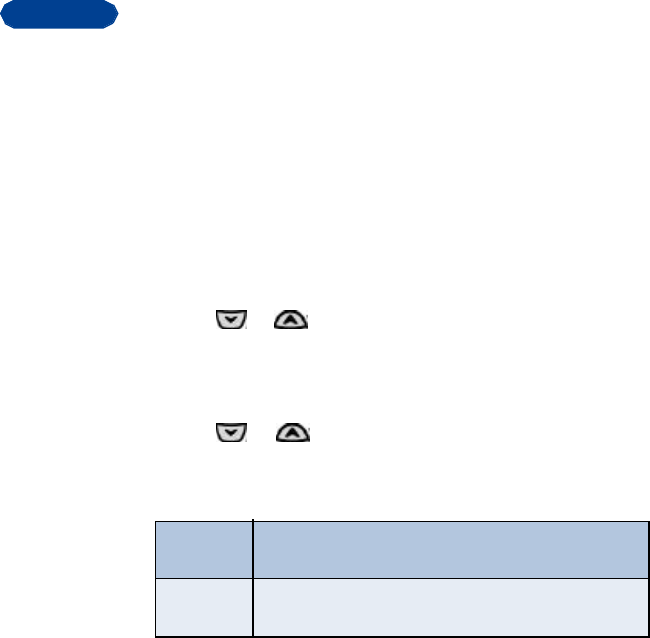
[ 58 ]
9Note: Car and Headset do not appear unless your phone has already
been connected to a car kit or headset at least one time.
3Select Customize and press OK.
4Scroll to Automatic answer and press Select.
5Scroll to On and press OK.
Set the lights (car kit only)
While your phone is connected to a car kit, you can set the phone’s lights
two ways. You can either have the lights on only when you use the phone
or have them on the whole time the phone is connected to the car kit.
This feature works only when your phone is connected to a car kit.
1Press Menu 3 (Profiles).
2Use or to scroll to Car and press Options.
Note: Car does not appear in the list unless the phone is connected to a
car kit.
3Highlight Customize and press OK.
4Use or to scroll to Lights and press Select.
5Scroll through your choices, which are listed and described in the
table below, and press OK.
Automatic Instructs the phone to turn off the lights within 15
seconds if no keys are pressed.
On Instructs the phone to leave the lights on the entire
time that your phone is connected to the car kit.

[ 59 ]
9
• RENAME PROFILES
1Press Menu 3 (Profiles).
2Use or to scroll to the desired profile and press Options.
3Scroll to Rename and press OK.
4Enter the new name and press OK again.
Note: You cannot rename the Normal, Headset, and Car kit profiles.

[ 60 ]
10 10 Personalize phone settings
• SET THE DISPLAY LANGUAGE
You can set your phone to display a certain language.
1Press Menu 4 > 3 > 1 (Settings > Phone settings > Language).
2Use or to scroll to the language you want to use and press
OK.
Your possible choices are American English, Canadian French, American
Spanish, Brazillian Portuguese, Russian, Hebrew, Ukranian and Chinese
Traditional. Language options will vary depending on where you live. All
of these languages may not be available in your phone.
• SET AND DISPLAY THE CLOCK
Your phone has an internal clock that you can set to appear on the
phone’s screen.
The clock is connected to an alarm clock. Refer to Alarm clock for more
information.
Set the clock
To set the clock to the appropriate time:
1Press Menu 4 > 2 > 1 (Settings > Time settings > Clock).
2Use or to scroll to Set the time and press Select.
The Time field appears.
3Enter the time using an 00:00 format and press OK.
For example, to set your clock to 9:30, enter 09:30. If you set the time
format for 24-hour time, enter the number the same way: 09:30 or 23:12.
•If you set time format to 12-hour, use [down] or [up] to scroll to am
or pm and press OK.

[ 61 ]
10
•If you set the time format to 24-hour, the time is set as soon as you
press OK after adjusting the time.
Display the clock
1Press Menu 4 > 1 > 2 > 1 (Settings > Time settings > Clock > Show/
Hide clock).
2To display the clock, highlight Show clock and press Select/Ok.
Select Hide clock if you wish to hide the clock once it is displayed.
Select the time format
You can change the way your clock shows the time, whether in 12-hour
format (am/pm) or 24-hour format.
1Press Menu 4 > 1 > 2 (Settings > Time settings > Clock).
2Use [graphic] or to scroll to Time format and press Select.
3Use [graphic] or to scroll to either 12-hour or 24-hour and
press OK.
• ADD A WELCOME NOTE
You can set your phone to display a welcome note each time you switch
on your phone. This note could say, for example: Hello. It could include
your name, a reminder, or more. The maximum length of this note is 45
characters.
1Press Menu 4 > 3 > 3 (Settings > Phone settings > Welcome note).
2Enter the text of the welcome note.
As you enter characters, they appear to the left of the cursor. Press Clear
to delete characters to the left of the cursor. Press [graphic] or [graphic]
to move the cursor right or left.
3Press Options.
4Use [graphic] or [graphic] to scroll to Save and press OK.

[ 62 ]
10 If you ever want to erase the welcome note, press Erase then OK.
under the options menu.
• USE 1-TOUCH DIALING
You must store names and numbers in your phone book before you can
use 1-touch dialing.
You can assign a name from the phone book to a 1-touch dial location,
using your phone’s keys 2 through 8. When you press the key, the
associated number is automatically dialed.
•Key 1: The 1 key is used exclusively to dial your voice mailbox.
•Key 2: You can use the 2 key to dial a customer care operator (refer
to “When you need to contact your service provider” XREF). You can
overwrite this feature and assign a 1-touch dial location to the 2 key.
Set up a 1-touch dial key
1Press Names and scroll to 1-touch dialing.
2Press Select.
3Use [graphic] or to scroll to the first number that includes the
message (empty) and press Assign.
4Use [graphic] or to scroll to the name and number to which you
want to assign this key and press Select.
Repeat these steps as many times as necessary.
5To call a number using 1-touch dialing, press and hold the appropriate
key for a few seconds.
The phone dials the number.
Change 1-touch dialing numbers
After you have assigned 1-touch dialing numbers to a key, you can change
key and number associations at any time.

[ 63 ]
10
1Press Names.
2Use [graphic] or to scroll to 1-touch dialing and press Select.
3Scroll to the key you want to change and press Options.
4Scroll to Change and press Select.
5Scroll through the phone book.
6When you reach the new number, press Select.
Erase 1-touch dialing numbers
You can erase 1-touch dialing key assignments at any time.
1Press Names
2Use [graphic] or to scroll to 1-touch dialing and press Select.
3Scroll to the key you want to erase and press Options.
4Scroll to Erase and press Select.
5Press OK.
• RESTORE FACTORY SETTINGS
You can change the default (factory) settings for your phone. Later, you
can return them to the original settings when needed.
Note: The memory, timers, language selection, security code, and lock
codes are not reset. However, any profiles you have modified are
reset when you restore your settings.
1Press Menu 4 > 2 > 4 (Settings > Phone settings > Restore factory
settings).
2Enter your security code and press OK.

[ 64 ]
11 11 Manage phone security
Your phone is equipped with a versatile security system that prevents the
unauthorized use of the phone.
You cannot activate or use certain phone features without having first
successfully entered your phone’s security code.
•The default security code is 12345.
•Nokia highly recommends that you immediately change this code.
Then, write down and store the new code in a safe place, away from
your phone.
When entering your security code, a * appears on the screen each time you
press a number key. This prevents others from seeing your code.
If you incorrectly enter a security code five times in a row, your phone
won’t accept any entries for the next 5 minutes. However, if you realize
that you’ve entered the code incorrectly before pressing OK, you can use
Clear <?> to erase the code, digit by digit, beginning with the last digit.
When this guide describes an action that requires the entry of your
security code, each step necessary to this action is provided.
• CHANGE YOUR SECURITY CODE
1Press Menu 4 > 3 > 2 > 4 (Settings > Security settings > Access
codes > Change security code).
The Security code field appears.
2Enter the default security code and press OK.
3At the message Enter new security code, enter your new security
code and press OK.
4At the message Verify new security code, enter your new security
code again and press OK.
The message Security code changed appears.

[ 65 ]
11
If you have changed your security code and don’t remember the new code,
contact your service provider. Once you have changed your security code,
the default setting is no longer valid.
• PROTECT YOUR PHONE WITH THE LOCK CODE
The lock code enables you to activate and deactivate your phone. When
the lock code is on, you cannot access most of your phone’s memory or
menu features. Also, you cannot make phone calls without first entering
the lock code.
Note: You can save an unlocked phone number and make calls to that
number without entering the lock code. Refer to “Store an
unlocked phone number” for more information.
With the lock code on, your phone locks when you switch it off. The next
time you switch your phone on, it asks you for a lock code when you press
either Names or Menu.
Note: If you enter an incorrect lock code five times in a row, your phone
prompts you for the security code.
•The default lock code is 1234.
•Nokia recommends that you change this code immediately.
Turn on the phone lock
1Press Menu 4 > 3 > 2 > 1 (Settings > Security settings > Access
codes > Phone lock).
2Enter the lock code and press OK.
3Scroll to On and press OK again.
When your phone is locked, it might be possible to place a call to the
emergency number programmed into your phone, such as 911 or any other
official emergency number. You can either dial this emergency number or
press the emergency key 9 (if you have activated the 9 key to act as an
emergency key).

[ 66 ]
11 Store an unlocked phone number
You can store a number in the unlocked phone number location. This
allows you to call the number even though your phone is locked.
1Press Menu 4 > 3 > 2 > 2 (Settings > Security settings > Access
codes > Unlocked phone number).
2Enter the lock code and press OK.
The Number field appears.
3Enter a phone number or press Search and scroll through the phone
book until the number you want to store appears.
4Press OK or Options.
5Scroll to Save and press OK.
Call an unlocked phone number
•Press or <down arrow> once, then <Talk>.
OR
•Manually enter the phone number and press <Talk>.
Answer a call while using a lock code
•To answer a call while using a lock code, press any key except <End>
and <Power>.
Change your lock code
1Press Menu 4 > 3 > 2 > 3 (Settings > Security settings > Access
codes > Change lock code).
The message Enter lock code appears. [graphic]
2Enter the lock code and press OK.
Only numeric characters are accepted.
3Enter the new lock code and press OK.
4Verify the new lock code, and press OK.

[ 67 ]
11
When you change your lock code, make sure you store it in a safe place,
away from your phone. Avoid entering access codes similar to emergency
numbers to prevent accidental emergency calls.
Turn off the lock code
1Press Menu 4 > 3 > 2 > 1 (Settings > Security settings > Access
codes > Phone lock).
2Enter the lock code and press OK.
3Scroll to Off and press OK again.
With the lock code feature turned off, you can use your phone without
having to enter the lock code each time you turn your phone on.
• LOCK THE KEYPAD
When you lock the keypad, you prevent accidental key presses—for
example, when your phone is in a pocket or purse. This feature is called
keyguard.
Activate keyguard
There are three different ways to activate the keyguard:
At the Start screen:
•Press and hold [End].
•Press Menu > [*+].
•Press Menu 9 (Keyguard).
When keyguard is turned on, you might be able to make calls to the
emergency number that is programmed into your phone. For example, you
could dial 911 and press .
Note: Keyguard is automatically turned off when the phone is connected
to a car kit.
Deactivate keyguard
•Press Unlock and then press OK.

[ 68 ]
11 Answer a call while keyguard is active
During an incoming call, the keypad automatically unlocks.
•Press [Talk] to answer the call.
After you end the call, keyguard automatically becomes active again.
•Press the Power key to quickly switch the lights on for 15 seconds.
• RESTRICT CALLS
You can restrict incoming and outgoing calls. To restrict outgoing calls,
you create a list of restrictions and apply the appropriate restriction.
Before you define restrictions for outgoing calls, only one restriction
option is available: Add restriction. You can create your own list of
outgoing call restrictions. The maximum number of call restrictions you
can define is ten.
After you have used the Add restriction option to add at least one
restriction, the following options are then available:
•Select: Allows you to select call restrictions from the outgoing calls
list.
•Edit: Allows you to edit an existing outgoing call restriction.
•Erase: Erases any existing outgoing call restrictions.
When calls are restricted, you might be able to make calls to the
emergency number that is programmed into your phone. For example, you
could dial 911 and press <Talk>. However, emergency key 9 might not
work, depending on the type of restriction you choose.
Restrict outgoing calls
1Press Menu 4 > 3 > 1 (Settings > Security settings > Restrict calls).
2Press Select.
3Enter your security code and press OK.
4Scroll to Add restriction and press OK.

[ 69 ]
11
5Enter the number you want to restrict and press OK.
Example: If you want to restrict all calls that begin with 1, enter 1.
This will restrict all outgoing long distance phone calls. If you want to
restrict all calls that begin with 972, enter 972, and so forth.
After step 5, the Name field appears.
•If you want to add a name for the call restriction, enter the name
using your phone’s keypad and press OK.
•If you don’t want to add a name, simply press OK.
Restrict incoming calls
1Press Menu 4 > 3 > 1 (Settings > Security settings > Restrict calls).
2Use <up arrow> or <down arrow> to scroll to Restrict incoming calls,
and then press Select.
3Enter your security code and press OK.
4Scroll to All calls and press Mark.
5Press Unmark to remove an already-set restriction.
6Press Back.
The Save changes? message appears.
7Press Yes.

[ 70 ]
12 12 Manage prepaid services
Some service providers offer prepaid cellular services. With prepaid
services, you can purchase cellular service time (air time) in advance.
When you’ve used the amount of time you purchased, you can restore
(replenish) the balance with another advance payment.
Service providers that offer prepaid services maintain access numbers
that you can use to check your balance and add money to your account.
•Contact your service provider to see if prepaid service is available and
to subscribe to the service.
When the service is activated, your phone’s screen shows the message
Prepaid menu enabled.
• ACTIVATE THE PREPAID MENU
The Prepaid menu on your phone makes it easy to
manage your prepaid account. You can easily check your account balance
and replenish (add money) to your account.
Before you can use the prepaid menu, you must activate it and enter your
access phone numbers.
??? The phone returns to the Prepaid menu. The Prepaid menu is the last
item in your phone’s menu listing. It is easy to access by pressing Menu
and .
When Prepaid menu is active, it replaces Keyguard as menu item 9.
Keyguard function is available (see page X).
• DEACTIVATE THE PREPAID MENU
You deactivate the Prepaid menu by contacting your service provider.
Once deactivated, the confirmation screen Prepaid menu disabled appears
and the phone returns to the start screen.

[ 71 ]
12
• SAVE ACCESS PHONE NUMBERS
After you have activated the Prepaid menu, you need to save the access
phone numbers used to check the balance and add money to your
account. After you save these numbers, you can use these services
through the Prepaid menu. Contact your service provider for the access
numbers.
1Press Menu > <???> and then press Select.
2Select Save access phone numbers.
When asked for the balance number, enter the phone number given
to you by your service provider.
3Press OK.
4When asked for the replenish number, enter the phone number given
to you by your service provider.
5Press OK.
• CHECK THE PREPAID BALANCE
1Press Menu > <???> and then press Select.
2Select Check balance.
3Listen to the audio notification of the balance of your prepaid
account.
4Press <End> to end the call.
• ADD MONEY TO YOUR PREPAID ACCOUNT
To add money to your prepaid account, you need a prepaid card. Contact
your service provider for prepaid card availability.
1Press Menu > <???> and then press Select.
2Select Add money to account.
3When asked for the prepaid card number, enter the number on your

[ 72 ]
12 prepaid card.
4Listen for a message, then press OK.
5Wait for notification, then press <End>.
If the operation was not successful, you need to restart from step 2.
• CHECK PREPAID BALANCES
Low balance: A low balance on your prepaid account is indicated by an
audio message before or during a call. This message from the service
provider may be repeated several times. Contact your service provider for
details.
Zero balance: A zero balance on your prepaid account during a call ends
your call. A zero balance before a call prevents both incoming and
outgoing calls. You may hear a message about your zero balance when
you try to make a call.
• MAKE CALLS USING PREPAID SERVICE
1Dial the number you want to call.
•If the account is active with a positive balance, the call is
connected. You may hear a message about your prepaid account
balance.
•If the account is active with a zero balance, the call is not
connected. You may hear a message saying that you have a zero
balance on your account.
•At the end of the call, you may hear a message about the current
balance on your account.
2Press <End> to end the call.

[ 73 ]
13
13 Set network services features
You can susbcribe to various network services whose availability depends
on your service provider. Your phone supports the network services listed
here. These services are not available from all providers or in all areas.
•Voice privacy
•Call waiting
•Call forwarding
•Sending own number
Feature code: When you subscribe to any of these services, your
service provider gives you a feature code that activates each service.
Deactivation codes are used to deactivate each service. After you
store the appropriate code, your phone sends the code to the network
to verify that you’re using the correct feature code.
Menus for network features: Menus for the services described here
appear on your phone only after you’ve stored the appropriate feature
code. You can use these menus to activate and deactivate the
network services.
Voice privacy: The voice privacy feature does not require you to store
a feature code before using it.
More than one number? If your phone has more than one phone
number assigned to it, any stored feature codes apply only to the
primary phone number.
• SET UP HOW YOUR PHONE SELECTS A SYSTEM
Your phone can operate in residential, private, and public systems (such
as your home system). You can choose how your phone selects a network
to use. Your phone may not show the options described here. For
information, contact your service provider.

[ 74 ]
13 Set up the way your phone selects a network
1Press Menu 5.
You see the following three options.
Automatic: Your phone automatically searches for available networks
and chooses the appropriate one. Every time you turn on your phone,
it resets to Automatic.
Manual: The phone searches for networks and then shows a list of all
the possible networks on your phone’s screen. Next to each network,
one of the following appears: Available or Not available. If a network
is designated as Not available, you cannot use it.
New Search: Your phone begins a new search for both private and
residential systems. When it finds the best system available, the
phone shows the system name. You can select this system or start
another search by pressing Next.
2Use or [down] to scroll through the choices, and press OK when
you see the system you want.
If you have two phone numbers, you can use the Manual and New
search options only with your primary phone number.
Switch between private and public systems
1Press and hold Menu while you are not in a call.
Your phone displays the message Search public systems?
2Press OK.
Your phone uses the public system for the next (and only the next)
outgoing call. After you complete this call, your phone returns to
automatic system selection.

[ 75 ]
13
Select a public system
When you take your phone outside its home system, the phone is said to
be roaming. The phone can search for home-type systems (that is, systems
of the same type as your home system). Or, the phone can search for non-
home-type systems.
Note: The options described here may not be available for your phone.
See your service provider for information.
Your service provider programs a list of preferred systems into your phone.
These are systems with which your service provider has roaming
agreements. Your phone looks for these systems when you’re roaming.
1Press Menu 4 > 5 > 7 to tell your phone how to choose a public
system (network).
Your selection remains active until you change it.
•Any system: When service is not available in your home system,
the phone searches for a preferred system of either type and then
searches for a home-type system. Then it searches for a non-
home-type system. The search continues until your phone finds a
system that can be used.
•Home type: When service is not available in your home system,
the phone searches for a home-type system first. However, if a
non-home-type system is found, then your phone will use this
system.
•Nonhome type: The phone searches for a non-home-type system
only. The home-type system is not used.
•Home only: The phone uses only its home system. It will not
roam.
2Scroll to the option you want and press OK.

[ 76 ]
13 • USE YOUR PHONE ON THE ROAD
When your phone is outside its home area, the phone is said to be
roaming. Calls made or received while you are roaming usually cost more
than calls made in your home area.
•When your phone begins roaming, the phone beeps once and may
show the word ROAM on the phone’s screen, depending on how
roaming works with your phone.
•When your phone is not roaming, it either shows the word HOME or
the name of your service provider.
•When you’re roaming in some systems outside your home area, the
system in which you’re traveling (the host system )may not recognize
your phone. You may not be able to place a call.
Contact your service provider for more specific information on how
roaming works with your phone and for information about coverage
limitations.

[ 77 ]
14
14 Communicate with text
messages
You can use your phone to send and receive short text messages if your
service provider offers the message feature and if you subscribe to the
service. You can also send and receive messages that contain a person’s
name and number (a “business card”).
• ABOUT TEXT MESSAGES
Message recipients: The phone to which you send a text message must
support text messages. Or, you can ask the service provider to convert the
message to other formats, such as e-mail.
Message length: The maximum length of a received text message is 160
characters. Your phone has space for up to 80 text messages, depending
on the length of each message.
Network variations: The maximum length of a text message depends on
the capabilities of the network from which the message originated. Also,
text messages may appear different at different times because messages
can originate in networks other than your own.
Contact your service provider for more information about text message
services.
• WRITE WITH STANDARD TEXT ENTRY
You can write a message two ways: using standard (ABC) text entry or
using predictive text. Standard text entry is the default method for text
entry. The ABC icon <ABC icon> appears as visual confirmation that
you’re using this method.
1Find the key that shows the letter you want to enter.
2Press the key as many times as needed for the letter to appear on the

[ 78 ]
14 screen.
For example, to enter the name John:
• WRITE WITH PREDICTIVE TEXT
With predictive text, you need to press each number key only once for
each letter. The phone “interprets” what you’re writing.
The word shown on the screen changes after each key stroke (as shown in
the example that follows). Since it’s easy to get confused, you should try
to disregard the word until you have entered all the characters.
Example: To write Nokia with the English dictionary selected:
What you press What you see Result
Press <5> J J
Press <6> <6> <6> M > N > O O
Press <4> <4> G > H H
Press <6> <6> M > N N
What you press What you see
Press <6> o
Press <6> on
Press <5> mol
Press <4> onli
Press <2> Nokia
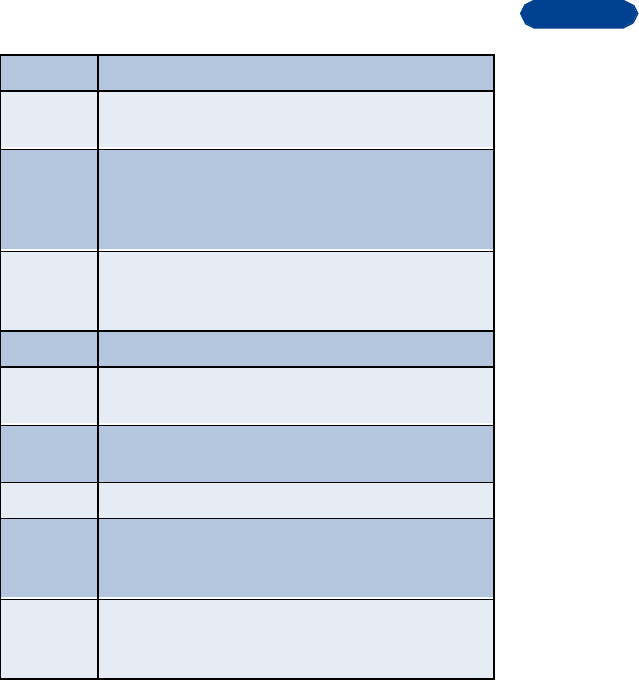
[ 79 ]
14
Keys and tools for predictive text
Turn on predictive text input
1Press Menu, then Select.
Key Purpose
Keys with
letters Use for word entry. Press each key only once for each
letter.
<*+> Press to view the next matching word if the underlined
word is not the word you intended. To change the
underlined word, press <*+> repeatedly until the word
you want appears.
Spell If the dictionary sees a word it doesn’t recognize, you
see Spell above the left selection key. Press Spell, enter
the word you want to enter, and press OK.
<0_> Press once to accept a word and add a space.
<#^> Press and hold to enter a number. <123 icon> indicates
123 mode. Press and hold again to write text letters.
Clear Press once to delete the character to the left of the
cursor.
<1> Press once to add a punctuation mark.
<#^> Press once quickly to switch the character case. <ABC
icon> indicates uppercase. <abc icon> indicates
lowercase.
160 Maximum number of characters available. The
character counter appears in the top right corner of the
screen and counts down for each character you add.

[ 80 ]
14 2When Text messages appears, press Select.
3Scroll to Write message and press Select.
4Enter a character using the keypad.
5Press Options, scroll to Dictionary and press OK.
6Scroll to the dictionary you want (for example, English).
7Press OK.
T9 dictionary activated appears. (“T9” is the technical name for
predictive text input.) This means you can use predictive text method
to enter messages. In the text message window where you write, the
predictive text icon <T9 icon> appears.
Turn off predictive text input
1Repeat steps 1 through 7 in “Turn on predictive text input.”
2Scroll to Dictionary off and press OK.
Tips for predictive text
1To insert a symbol, press and hold <*+>.
The symbol screen appears, showing the following characters:
. , ? ! : ; - + # * ( ) ‘ “ _ @ & $ % / < > =
2Scroll to the symbol you want and press Insert.
When you’ve finished writing, make sure the underlined word is the
word you intended to write.
If the word is correct:
•Insert a punctuation mark, if needed.
•Press <#^> to confirm the change and enter a space.
•Start writing the next word.
If the word is not correct:
•Press <*+> repeatedly until the word you want appears, then
press <0_> to confirm it.

[ 81 ]
14
OR
•Press Options, scroll to Matches, then press OK. Scroll to the
correct word and press Use.
•Start writing the next word.
When you enter a period to end a sentence, the phone switches to
<ABC> mode so the that the first letter in the next word will be
uppercase (a capital letter).
Add a word to the match list
If the ? character appears after a word, the word you intended to write is
not in the dictionary. You can add the word to the dictionary.
1Press Spell and enter the word(s) using standard text entry.
2Press OK to save the word(s).
Insert numbers
1To add a number to the message, press and hold <#^> until <123
icon> appears.
2Enter the numbers you want, then press and hold <#^> to return to
ABC mode.
Insert symbols
1To put a symbol in the message, press Options and scroll to Insert
symbol (or press <*+> and scroll to the symbol you want).
2Select the symbol you want (use the scroll keys to move through the
symbols) and press Insert.
Write compound words
1Write the first part of the word and press <0_> to accept it.
2Press Clear once to remove the space.
3Write the last part of the compound word and press <0_> to enter
the word in memory.

[ 82 ]
14 • USE FOLDERS TO STORE TEXT MESSAGES
Your phone has four folders for managing text messages.
Inbox: The Inbox is where your received messages are stored. Messages
will remain in the Inbox until you delete them or save them to the Archive
folder
Outbox: The Outbox is the folder where your created, sent and forwarded
messages are stored.
Archive: The Archive folder is for storing messages you wish to save.
Templates: The Templates folder is a folder for storing message templates
that you create.
• WRITE AND SEND A TEXT MESSAGE
1Press Menu 1 > 1 (Messages > Messages > Write message).
The message screen appears.
2Enter a message of up to 160 characters.
To learn how to enter text quickly, refer to “Write with predictive text
input.”
3When you’ve finished writing, press Options, scroll to Send, then
press OK.
4Enter or recall the recipient’s 10-digit phone number, then press Send.
Sending message appears. When the message is successfully sent,
Message sent appears.
If you need to exit while writing the message, press <End> at any time.
Later, press Menu 1 > 1 > 3 to return and finish writing the message. If
you turn off the phone without saving the message, the message will be
lost.

[ 83 ]
14
• SAVE A MESSAGE IN THE SAVED FOLDER
When you write a text message, it’s a good idea to save it in the saved
folder. Then if there is a message delivery problem, you can easily resend
the message.
1While writing the message, press Options.
2Scroll to Save, then press OK.
• RESEND A MESSAGE FROM THE OUTBOX
A message in the outbox shows one of two icons:
•The <blank note icon> icon shows that you have attempted to send
the message to the text message center.
•The <envelope icon> icon shows that you have not yet tried to send
the message.
1Scroll to the message, then press Read.
2Press Options.
3Scroll to Forward, select As a message, and press OK.
4With Send highlighted, press OK.
5Enter or find the number to which you want to send the message,
then press Send.
• RECEIVE A TEXT MESSAGE
When you receive a text message, the phone plays a message alert tone
and the text message icon <icon> appears, along with one of the
following messages:
•Message received: Means that you have an unread message or page.
If you have more than one message or page, the appropriate number
is listed before this message.
When you receive the above message along with another message
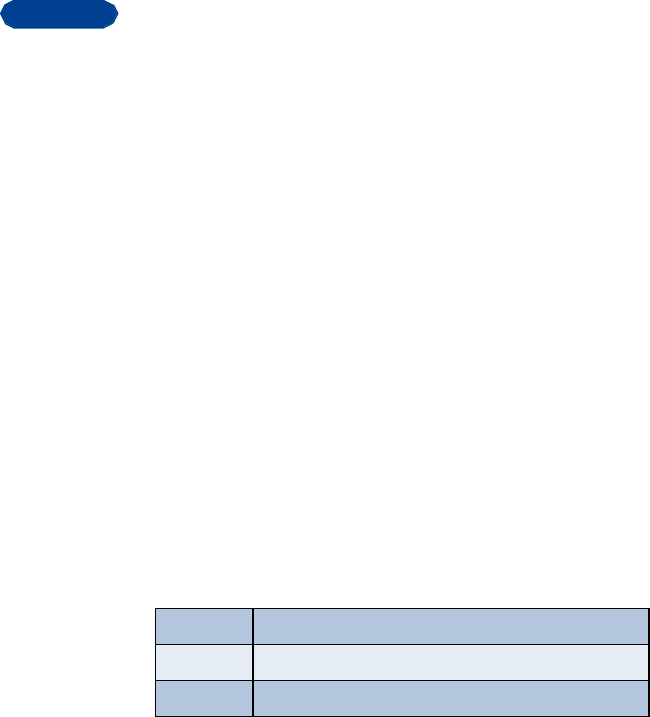
[ 84 ]
14 call, followed by a name or number, the message is a page. Only the
names of people who are stored in your phone book appear.
•New emergency message: Means that an emergency message or
page was sent by someone via the service provider. Emergency
messages are sent only in situations where life or property are in
immediate danger. Emergency messages are listed first and override
all other messages.
•Urgent: Means the message has a high priority.
• READ A TEXT MESSAGE
1Press Read.
This takes you to the inbox, where the new message is selected.
2Press Read again to read the message.
3Press Options for a list of choices you have while reading the message
(see the list following this section).
4Press OK when the option you want is highlighted.
In your inbox, text messages are shown in the order in which they
were received, unless one is an emergency message. An emergency
message overrides any other message and appears first.
Choose options for a message
When you press Options while reading a message, the following choices
are available.
Read next Takes you to the next message.
Erase Erases the current message.
Save Saves this message in the Saved folder.

[ 85 ]
14
• WHEN YOUR PHONE’S MEMORY IS FULL
When your phone’s message memory is full, one or more messages of the
lowest priority are automatically deleted. These messages are usually
deleted from your phone’s outbox. An incoming emergency message could
force a deletion from your phone’s Saved folder.
•If after deleting messages the memory is still full, your phone shows
the message No space: message waiting. The <text message
envelope icon> blinks.
•Clear the notification by pressing OK.
• ERASE A MESSAGE
1While reading a message, press Options.
2Scroll to Erase, then press OK.
Your phone asks you to confirm that you want to erase the message.
3Press OK.
Call back
Calls the person who sent you the text message, if their
phone number is included in the message. You can also
press <Talk> while the message is displayed to dial the
number.
If more than one number is on the screen, the numbers
appear in a list. Scroll to the phone number you want
to call and press <Talk>.
Forward Forwards the call to another person. That person must
have the appropriate message service.
Reply Provides a screen where you can write a reply.

[ 86 ]
14 • REPLY TO A MESSAGE
1While reading a message, press Options.
2Scroll to Reply, then press OK and choose whether your message will
be sent as a text message or as e-mail.
3Enter your message, then press Options.
4Scroll to Send, then press OK.
The phone shows the return number.
5Edit the number if needed, then press Send.
• FORWARD A MESSAGE
1While reading a message, press Options.
2Scroll to Forward, then press OK and choose whether your message
will be sent as a text message or as e-mail.
3Press Options, or edit the message and press Options.
4Scroll to Send, then press OK.
5Enter or find the recipient’s phone number, then press Send.
• SEND AND RECEIVE E-MAIL MESSAGES
You can use your phone to send and receive e-mail messages. This means
you no longer need to be at your computer to send or receive messages.
The e-mail feature is not available from all service providers.
Save e-mail addresses
You can add an e-mail address to a name you’ve already saved in the
phone book. Or, you can add a name and address as a new entry.
SAVE AN E-MAIL ADDRESS FOR AN EXISTING NAME
1At the Start screen, press Names and then, at Search, press Select.
The Names box opens.

[ 87 ]
14
2Enter the first two letters of the name you want to find and press OK.
3Press Options (or press Details if the Name list view is selected in your
phone book), scroll to Email address, and press Select.
The e-mail address box opens.
4Enter the address.
Press <1> once for a dot (.) Press <1> repeatedly to insert an @ sign.
Press OK when you see the character you want to insert.
5When you’ve finished entering the address, press OK.
The message Saved appears briefly, confirming your action.
ADD A NEW E-MAIL ADDRESS
1At the Start screen, press Names, scroll to Add new, and press Select.
The Names box opens.
2Enter the name and press OK.
The Number box opens.
3Enter the phone number and press OK.
The message Saved appears briefly, confirming your action.
4Press Options, scroll to Email address, and press Select.
The e-mail address box opens.
5Enter the address, using <1> to insert the “dot” (.) and @ signs.
6Press OK.
The message Saved appears briefly, confirming your action.
CHANGE (EDIT) AN E-MAIL ADDRESS
1Follow steps 1 through 3 in “Save an e-mail address for an existing
name” (earlier in this section) to find the name whose e-mail address
you want to edit.
2Enter any changes, using <up arrow> and <down arrow> to move the
insertion point backward and forward in the address.

[ 88 ]
14 3When the address is the way you want it, press OK.
The message Saved appears briefly, confirming your action.
Send an e-mail message
1At the Start screen, press Menu and then, at Messages, press Select.
2At Text messages, press Select, scroll to Write email, and press Select
again.
The e-mail address box opens. If your phone asks for an e-mail
gateway number, contact your service provider.
3Enter the e-mail address, or press Search.
•If you press Search, enter the first few letters of the name you
want and press OK when you find the name. The address appears
in the Recipient address box. Press OK.
•The phone lists all the names from your phone book. If you select
a name for which there is no e-mail address, your phone shows
the message, No e-mail address for this name.
•If you enter the e-mail address, press OK when you’ve finished.
The Subject box opens.
4Enter a subject and press OK.
The subject line can hold a maximum of 26 characters. You can leave
the line blank if you wish.
5When the message screen appears, enter your message.
The maximum number of characters for message length varies; check
with your service provider for details.
You can turn on predictive text input if you wish. For information, see
“Write with predictive text input.”
6When you’ve finished the message, press Options, select Send, and
press OK.
A status message tells you the mail is being sent.

[ 89 ]
14
Other options for a completed message
• REPLY TO OR FORWARD AN E-MAIL MESSAGE
1If the message is not on the screen, press Menu > Message > Text
messages > Inbox (Menu 1 > 1 > 1).
2Select the message you received and press Read.
3Press Options, scroll to Forward or Reply, and press OK.
4Scroll to As email and press Select.
If your phone asks for an e-mail gateway number, see your service
provider.
5Enter the recipient’s e-mail address or press Search to find the name.
•If you press Search, enter the first few letters of the name you
want and press OK when you find the name. The address appears
in the Recipient address box. Press OK.
•The phone lists all the names from your phone book. If you select
a name for which there is no e-mail address, your phone displays
the message, No e-mail address for this name.
•If you enter the e-mail address, press OK when you’ve finished.
6Enter a subject line and press OK.
The subject line can hold a maximum of 26 characters. You can leave
the line blank if you wish.
7When the message box opens, write your reply or any message you
want to add when you forward the mail.
Save Saves the message in the saved folder until you send it.
Erase Erases the message and returns you to the Recipient
address box
Quit Erases the message and returns you to the Start screen.

[ 90 ]
14 You can turn on predictive text if you wish. For information, see
“Write with predictive text input.”
8When you’ve finished your message, press Options, scroll to Send,
and press OK.
• CHAT WITH OTHER PHONE USERS
You can have a conversation with another person using text messages.
You can start by using the Chat menu or by selecting the Chat option
while you’re reading a received message.
1Enter the other party’s phone number or recall it from the phone book
and press OK.
2Enter a nickname for the chat session (see Writing text ) and press OK.
3Write your chat message, press Options, and press Send.
The reply from the other party is shown above your original message.
4Press OK to clear the screen and reply to the message.
5To view the previous message or edit your nickname, press Options
and select Chat history or Chat name.

[ 91 ]
15
15 Use special features
• SEND AND RECEIVE BUSINESS CARDS
Your phone can send or receive electronic business cards consisting of a
name and phone number. You can save received business cards in your
phone book.
Send a business card
1Find the name in your phone book.
2Press Options and scroll to Send bus. card.
3Press Select.
4Enter or recall the phone number to which you want to send the
business card, and press Send.
View a received business card
When you receive a business card, the phone shows the message Business
card received.
Note: If you press Exit at any time before you save the business card, the
business card is deleted (erased).
1When your phone shows Business card received, press Options.
Show is selected.
2Press OK.
3Scroll through the available information.
Save a viewed business card
1After viewing the business card, press Back, scroll to Save, then press
OK.
2When asked for a name, edit the name if you want to, then press OK.
3When asked for a number, edit the number if you want to, then press

[ 92 ]
15 OK.
Delete a viewed business card
• After viewing the business card, press Back, then press Exit.
OR
•Press Discard, then press OK.
• DOWNLOAD RINGING TONES
You can download (transfer) up to five ringing tones to replace the
personal entries in your list of tones. Ringing tones can be ringing sounds
or short tunes. For details about this network service, contact your
wireless service provider.
Note:If you press Exit at any time before you save the ringing tone, the
ringing tone will be deleted.
Receive a ringing tone
If you have this service and your phone receives a downloaded ringing
tone, your phone shows the message Ringing tone received.
1Press Options.
Playback is selected.
2Press OK.
The phone plays the ringing tone.
Save a received ringing tone
1If you want to save a ringing tone after you’ve listened to it, press
Back.
2Scroll to Save tone, then press OK.
3Choose which ring tone you want to replace—either an empty
personal placeholder, if any are remaining, or a previously
downloaded tone.

[ 93 ]
15
4Press OK.
The phone saves the new tone in the list of ring tones.
Discard received ringing tones
You can discard a ringing tone if you don’t want to save it.
•Press Exit .
OR
•Scroll to Discard tone, then press OK.
• USE THE ALARM CLOCK
The alarm clock is based on the time settings in your phone’s clock. You
can set the alarm clock to ring at any time, even if your phone is turned
off.
•The alarm clock’s volume is determined by the phone’s current volume
and tone settings.
•If you have selected the Silent or Beep once ringing tone, the alarm
clock quietly beeps once.
Warning: Do not switch on the phone where wireless phone use is
prohibited or where it might cause interference or danger.
Even if you are merely setting the clock, your phone is active
when it’s on.
SET THE TIME
•To set the time, see “Set and display the clock.”
SET THE ALARM CLOCK
1Press Menu 4 > 2 > 2 (Settings > Phone settings > Alarm clock).
The Set alarm time message appears.
2Enter the time for which you want to set the alarm and press OK.
Use the hh:mm format (03:40, for example). The alarm clock replaces
any existing numbers with the new time.

[ 94 ]
15 3Select either am or pm.
The am and pm options appear only if you’ve chosen the am/pm
format for the clock.
4Press OK.
The Alarm on message appears.
TURN OFF THE ALARM CLOCK WHEN IT RINGS
When the alarm clock rings:
•Press Stop to turn it off. The phone asks if you want to keep the phone
on. Press Yes or No. If you select Postpone, the phone will stay off
until the next alarm time.
•Press Snooze to set the alarm to go off again in 10 minutes.
If you let the alarm ring for 1 minute or more without pressing a key, it
stops ringing, waits 10 minutes, and then rings again. This continues until
you press Stop.
If you have selected the Silent or Meeting profile, the alarm beeps only
once. The best profile to use with the alarm clock is Normal or Outdoor,
unless these profiles have been modified from their original settings.
TURN OFF THE ALARM CLOCK ALTOGETHER
If you want to turn the alarm clock completely off:
1Press Menu 4 > 2 > 2 (Settings > Phone settings > Alarm clock).
2Use or <down arrow?> to scroll to Off and press OK.
• USE THE CALCULATOR
Your phone’s calculator adds, subtracts, multiplies, divides, and converts
currencies.
1Press Menu > Calculator (Menu > 7).
2Enter the first number in the calculation.
To enter a decimal point, press <#^> to add the decimal point.
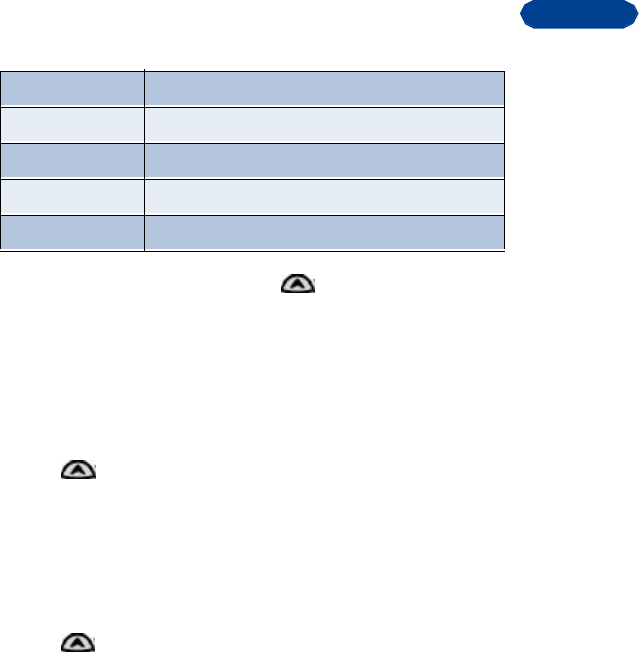
[ 95 ]
15
3Based on the type of calculation that you need to perform, use one of
the following actions:
Or, you can press Options and then use or <down arrow> to scroll
to: Equals, Add, Subtract, Multiply, Divide, To home, To visited, or
Exchange rate.
4Press OK.
5Enter the second number in the calculation and press Options.
You can repeat steps 4 and 5 as many times as necessary. Press Clear to
erase any mistakes.
6Use or <down arrow> to scroll to Equals and press OK.
Convert currency
You can use the calculator to first set the exchange rate and then to
calculate the exchange rate.
SET THE EXCHANGE RATE
1Press Menu > Calculator (Menu > 7), then press Options.
2Use or <down arrow> to scroll to Exchange rate and press OK.
3Select the exchange rate: How many home units to a visited unit, or
How many visited units to a home unit.
4Press OK.
The exchange rate box opens, with the number 1.
If you want to... ...Do this
Add Press * (for + symbol)
Subtract Press ** twice (for - symbol)
Multiply Press *** (for * symbol)
Divide Press **** (for / symbol)

[ 96 ]
15 5Enter the appropriate number and press OK.
The number 1 is overwritten by the number you entered. To enter a
decimal point, press <#^>.
6Press OK.
The Rate saved message appears.
CALCULATE CURRENCY USING THE EXCHANGE RATE
1Press Menu > Calculator (Menu > 7).
2Enter the number of units for the exchange rate.
3Press Options and scroll to To home or To visited.
•To home converts visited units of currency to home units using the
exchange rate.
•To visited converts home units of currency to visited units using the
exchange rate.
4Press OK.

[ 97 ]
16
16 Use Infrared
Use the Infrared menu (<Menu ?>) to activate communications between
your phone and other devices through its infrared (IR) port.
To connect via IR, the device with which you want to connect must be
IrDA compliant.
Your Nokia phone is a Class 1 Laser Product.
Note: The preferable distance between the two devices in infrared
connection is a range of 3 inches to three feet maximum. There
must be no obstructions between the two devices and the IR ports
of the two devices have to be pointing at each other.
• SENDING AND RECEIVING DATA
Your phone has the ability to send and receive certain types of data via
the infrared port; no additional cable or software is needed.
You can send and receive phone book entries (business cards), and
reminder notes via IR. Transmission/reception must be to/from a
compatible phone or device (for example, another phone, computer or
handheld device).
LEARN ABOUT SENDING OR RECEIVING VIA IR
1Ensure that the IR ports of the two devices are pointing at each other.
2IR must be activated via the IR menu prior to sending or receiving.
3The user of the sending device selects the desired IR function to start
data transfer.
If data transfer is not started within 2 minutes after the activation of the
IR port, the connection is cancelled and has to be started again.
Check the status of an IR connection
The status of an IR connection is indicated by [graphic] .
•When [graphic] is shown continuously, there is an IR connection

[ 98 ]
16 between your phone and the other device.
•When [graphic] is not shown, no IR connection exists.
•When blinks, your phone is trying to connect to the other device or
the connection has been lost.
Other types of IR connections
You can also establish a 2-way connection between your PC or laptop
computer and your phone via infrared. With this type of connection, your
phone can:
•function as an external modem connected via IR. Use your existing
data software (Dial-up Networking, AOL, etc.) or fax software
(WinFax Pro, HotFax, etc.) to send and receive faxes, connect to the
Internet, or check e-mail. For more information, see <the website for
the PC connectivity information>.
•synchronize it’s phone book and reminders with some of the most
popular Personal Information Manager (PIM) programs on the market
(Outlook, ACT!, Lotus Organizer, Gold Mine, etc.). Use the FoneSync
application found on <the Nokia website> in
conjunction with your existing PIM application to keep all of your
information up-to-date.
Phone book
Your phone can transmit its phone book information using the industry
standard v.card format via it’s infrared (IR) port. “Business cards” (v.cards)
can be sent to another phone, a PC (running the appropriate software) or
other IR-equipped handheld devices (such as Palm™, and Psion Series 5™).
SEND A BUSINESS CARD TO ANOTHER DEVICE
Note: Make sure that the other phone or device is set to receive data via
its IR port. Please refer to the user guide for the receiving device
for more information on enabling IR communications and
receiving data over IR.
1Press the [?] and scroll to the desired phone book entry. Press the [?]
twice.

[ 99 ]
16
2Scroll to Send card via IR (to send phone book entry).
3Align the infrared ports of both devices, then press the (?).
RECEIVE A BUSINESS CARD FROM ANOTHER DEVICE
To receive business cards from another compatible phone, you need to
first enable infrared communications using the Infrared menu (<Menu
?>). Then, the user of the other phone or devices sends you a business card
as described above.
Once you have received the name and phone number, press Show. Then
press Options, select Save or Discard, and press OK.
Reminders
You can send and receive reminder notes between phones, as well as
between other IR-equipped devices (such as Palm™, and Psion Series 5™).
Note: Make sure that the other phone or device is set to receive data via
its IR port. Please refer to the user guide for the receiving device
for more information on enabling IR communications and
receiving data over IR.
SEND A REMINDER NOTE TO ANOTHER DEVICE
1Scroll to the reminder you wish to send and press the (?).
2Scroll (if necessary) and highlight the desired reminder and press
Options.
3Scroll to Send reminder and press the (?).
4Align the infrared ports of both devices
5Highlight Send via IR and press the (?) to initiate data transfer.

[ 100 ]
17 17 Connect to the Internet*
WAP (short for Wireless Application Protocol) is to mobile devices what
WWW (world wide web) is to desktop computers. The mobile community
began developing WAP several years ago to give mobile device users
access to the internet. Today, most WAP sites are made up of text and
hyperlinks, with some capable of text input and selection items in a list.
Some pages even contain low-resolution graphics. Because your service
provider and others are free to design WAP sites as they choose, each site
can vary almost as much as a web page on the Internet.
• LEARN ABOUT THE SERVICES MENU
The Services menu allows you to use your WAP browser to view news,
weather reports, check flight times, access financial information, and
much more. You can also save the address of any WAP page as a
bookmark, much the same as a web page on your personal computer.
Note: You may need to subscribe to additional services before you’re
able to use the browser. Also, your service provider may have to
configure your phone for browsing after you’ve subscribed.
Contact your service provider for more information.
Important: Internet content received over a secure connection and
stored in your browser’s cache may be reused over non-
secure connections and may create security issues. Please
check with your service provider to determine if emptying
your browser’s cache after each browsing session or some
other method should be used to avoid security issues.

[ 101 ]
17
• SET UP FOR BROWSING
It shouldn’t be necessary to manually configure your phone for browsing.
Normally your service provider will modify these settings once you’ve
subscribed to this feature. Contact your service provider if you have
problems using the browser.
• YOUR SERVICE PROVIDER AND WAP
Because WAP content is designed to be viewed from your phone, your
wireless provider now becomes your “wireless Internet service provider“
as well.
It’s likely that your service provider has created their own home page and
configured your browser to go to this page when you press Home on the
browser’s menu. Once at your service provider’s home page, you’ll find
links to a number of other WAP sites.
• LAUNCH THE BROWSER*
1At the Start screen, press Menu.
2Scroll until Services appears and press Home.
Your phone connects to the Internet and is directed to your service
provider’s home page.
Note: If your phone displays Check service settings, it may not be
configured for browsing. Contact your service provider to make
sure that your phone is configured properly.
Note: Pressing [end] terminates any active browser session and returns
you to the Start screen.
Navigate a WAP card
Elements common to most pages [graphic]
•Header line - shows the current location.
•Active hyperlink - highlighted and awaiting a press of the (?).

[ 102 ]
17 •Hyperlink - used to navigate to other cards or sites. Scroll to select
the link and click the (?).
•Text - use the (?) to scroll through the text. The cursor will
automatically jump to the next hyperlink to activate it. [graphic]
•Selection list - identified by text in brackets. Click this link to display
additional choices or links.
•Options/Back - Displays a card’s options menu and/or the browser
menu. Back takes you back to the previous page.
•Data entry field - identified by ellipse in brackets [...]. This field is used
when specific user input is required (example: city name, stock
symbol, airline name or flight number, etc.). To edit this field:
[graphic]
1Highlight the data entry field and press the (?).
2Enter the text requested by the data entry field (for example: Miami)
and press OK. [graphic]
The text you entered is now displayed between the brackets.
3Scroll to the link that requires an action (For example: get forecast?)
and press the (?).
The browser menu
1At the Start screen, press Menu.
2Scroll until Services appears and press the (?).
The following menu items are available. Use the (?) to highlight and
select.
•*Home....................Starts the browser and takes you to your service
provider’s home page.
•*Bookmarks.........Displays a list of all saved bookmarks.
•Settings .............From here you can modify your connection settings,
appearance settings, and Security certificate more.
•Go to address.....Allows you to enter the address of your choice.

[ 103 ]
17
•Clear the cache......Empties the browser’s temporary memory and
frees up space. It’s advisable to empty your cache at the end of each
session.
Note: Some service providers may have customized the Services menu
WAP page’s Options menu. Please contact your service provider for
more information, in the event that any of the above menu
options are unavailable.
The Options menu
Press Options while browsing. The following menus appear on screen:
•Home.......................Takes you back to your home page.
•Bookmarks.............Displays a list of all saved bookmarks.
•Edit or Select........Allows you to edit the currently selected browser
element (for example, a checklist or text entry field), or selects the
active (highlighted) hyperlink.
•Go to address........Allows you to enter the address of your choice.
•Use Number..........Captures a phone number displayed on the card to
place a call or add the number to the phone book.
•Clear the cache...Empties the browser’s temporary memory.
•Exit...........................Exits the current session and returns to the Start
screen.
ADDITIONAL MENU ITEMS
Developers of WAP web sites can add more Options menu items specific
to their web site. These options are often links to other areas within the
site. As with any other menu item, scroll the (?) to highlight and press the
(?) select.

[ 104 ]
17 • BOOKMARKS
You can save the address of your favorite sites as bookmarks. If a WAP
site’s developers have included a title for the card, then the name of the
card will appear in the bookmark list (example: Yahoo! News, ebay on
WAP, Mapquest).
If the site has no title, then the site’s address will appear in the list of
bookmarks (example: http://www.yahoo.com/news.wml).
SAVE AN ADDRESS AS A BOOKMARK
1Navigate to the desired site and press Options.
2Scroll to Bookmarks and press the (?).
3Press Options.
4Scroll to Save as bookmark and press Select.
ENTER A BOOKMARK MANUALLY
1At the Services menu, press the (?).
2Scroll to Bookmarks and press the (?).
3Press Options, scroll to Add bookmark and press the (?).
4Enter the site’s address (example: my.yahoo.com) and press OK.
Note: It is not necessary to enter http://. This is added automatically.
5Enter a title for the new bookmark and press OK.
RETURN TO A BOOKMARKED SITE
1At the Services menu, press the (?).
2Scroll to Bookmarks and press the (?) again.
3Scroll to the desired bookmark and press the (?).
If you are not currently browsing, the phone will connect to the internet.

[ 105 ]
17
• DOWNLOAD A RING TONE
You can download up to five ringing tones to your phone through SMS or
some WAP sites. For more information about downloading ringing tones,
contact your service provider.
• PLAY, SAVE, OR ERASE A RING TONE
Once you’ve downloaded a ringing tone, your phone displays the message
Ringing tone received.
1Press Options, then choose Playback, Save, or Erase.
Press OK.

[ 106 ]
18 18 Play games
Not only can you use your phone for communication but also for some
serious fun. Your phone offers you three games from which to choose.
•In Snake 2, you are to feed the snake with as many goodies as
possible. The longer the snake’s tail grows, the higher your score.
•In Space Impact 2, the object is to get all the numbers in sequential
order as you rotate the numbers and move them.
•In Pairs 2, you will play the traditional game of tennis. Use the (?) to
control the racket.
Warning: Do not switch on the phone when wireless phone use is
prohibited or when it may cause interference or danger.
Start a new game
1Go to the Games menu, scroll to the desired game and press the (?).
2Select New game.
Use the option Instructions to learn how to play the game. With the
option Level you can choose the difficulty level of the game.
(In Snake you can pause the game by pressing either selection key and
then resume a paused game with the option Continue. Use Top score
(available in some games) to check the high score in your phone.) ??
• SNAKE 2
• SPACE IMPACT 2
• PAIRS 2

[ 107 ]
19
19 Frequently asked questions
(FAQ)
This section lists and answers the questions phone users most frequently
ask.
Some of the answers tell you to use menu shortcuts. For a complete listing
of these shortcuts, refer to <“List of shortcuts”> .
Q. How do I lock my phone?
A. Press Menu 4 > 3 > 2 > 1 (Menu > Settings > Security settings >
access codes), enter your lock code, scroll to On, and press OK.
Q. How do I unlock my phone?
A. Press Menu 4 > 3 > 2 > 1 (Menu > Settings > Security settings >
access codes), enter your lock code, scroll to Off, and press OK.
Q. What is my lock code?
A. The lock code enables you to lock your phone, thus preventing
someone else from using it. The default lock code is 1234. However,
it is suggested that you change this code immediately.
Q. What is my security code?
A. The default security code is 12345. However, it is suggested that you
change this code immediately. Certain features can be used only after
the correct security code has been successfully entered.
Q. How do I lock the keypad?
A. There are three ways you can lock the keypad: press and hold , press
Menu , or from the Start screen, press Menu > 9 (Menu > Keyguard).
The term Keyguard is also used in connection with this feature.
Q. How do I unlock the keypad?

[ 108 ]
19 A. There are two ways you can unlock the keypad: press and hold and
then press OK, or press Unlock and . The term Keyguard is also used in
connection with this feature.
Q. How do I make the ringing louder?
A. Press Menu 3 > 1 > 2 > 2 (Menu > Profiles > Normal >
Customize > Ringing volume), then choose a volume level.
Q. How do I change the ringing tone?
A. Press Menu 3 (Menu > Profiles) and scroll through the list of profiles
until you find the one for which you want to set the ringing tone, then
press Options.
•Highlight Customize and press OK.
•Scroll to Ringing tones, then press Select.
•Scroll through the options. After you hear the tone you want to
use, press OK.
Q. How do I store my voice mailbox number?
A. Press Menu 1 > 2 > 2, enter your voice mailbox phone number, and
press OK. The screen tells you that the number is saved. Then the
following message appears: Save hidden voice mailbox password?
Press Yes to save this number.
This voice mailbox number is valid unless your phone number
changes. If your phone number changes, you will have to save a new
voice mailbox number.
Q. How do I call my voice mailbox number (retrieve voice messages)?
A. When your phone alerts you to new voice messages, press Listen and
follow the instructions on the phone. If you’d rather listen to your
messages later, press Exit.
To listen to your voice messages at a later time, perform one of the
following actions:

[ 109 ]
19
•Press and hold the 1 key.
•Press Menu 1 > 2 > > 1 (Messages > Voice messages > Listen to
voice messages). The message Calling voice mailbox appears on
the screen. Follow the prompts to access your messages.
Q. How do I find my phone’s model number?
A. Turn your phone off, then remove the battery from the back of the
phone. On the sticker that is on the rear cover, after the word Model,
your phone’s model number is printed.
Q. How do I redial the last-dialed number.
A. Press twice, quickly.
Q. How do I assign a key to 1-touch dialing?
A. Press Names and scroll to 1-touch dialing.
Press Select.
Use [graphic] or to scroll to the first number that includes the
message (empty) and press Assign.
Use [graphic] or to scroll to the name/number to which you
want to assign to this key and press Select.
Repeat these steps as many times as necessary.
Q. How do I find out how many memory locations the phone has?
A. Press Names and scroll to Options.
Press Select.
Scroll to Memory status and press Select again. A message appears
that says Phone: xx free, xx in use where xx indicates the amount of
memory locations.
Q. How do I find my phone’s ESN (electronic serial number)?

[ 110 ]
19 A. Turn your phone off. Remove the phone’s back cover, grasp the ridge
at the end of the battery with a fingernail, and lift the battery out. On
the inside of the phone, on the sticker that was beneath the battery,
after the letters ESN, your phone’s ESN appears.
Q. How can I change the contrast of my phone’s display?
A. The contrast of your phone’s display is fixed and cannot be changed.
Q. How do I clear my call timers?
A. WARNING: The clearing of call timers cannot be undone.
Press Menu 2 > 5 > 5 and when the Security code field appears, enter
your security code and press OK.
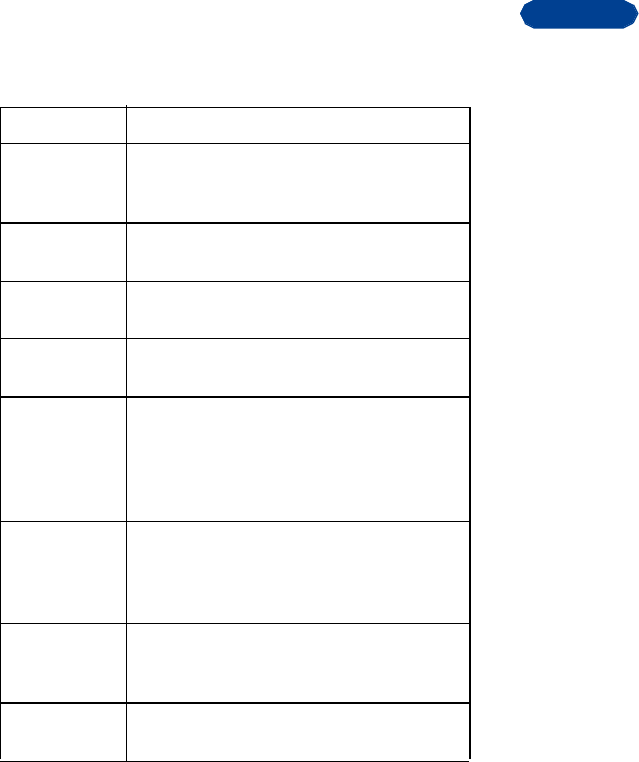
[ 111 ]
20
20 Glossary
Term Definition
analog network A network where the signal is conveyed by
varying the frequency, amplitude or phase of
the transmission.
antenna The portion of your phone designed to transmit
and receive the wireless signal.
antenna jack The connector used to attach an external
antenna to your mobile phone.
battery The source of power for your mobile phone
when the phone is not connected to a charger.
bookmark A way to save a web site address (or URL) to
your phone’s memory. Use bookmarks to store
the addresses of your favorite web sites, then
recall them so you can return to the location
quickly and easily.
browser A software program used to view and navigate
a portion of the Internet called the World Wide
Web, or Internet locations developed for the
Wireless Application Protocol (WAP).
data call A call in which your Nokia phone functions as a
data/fax modem, connected to your PC via the
infrared port.
digital network Network where the signal is converted to a
digital or binary code before transmission.
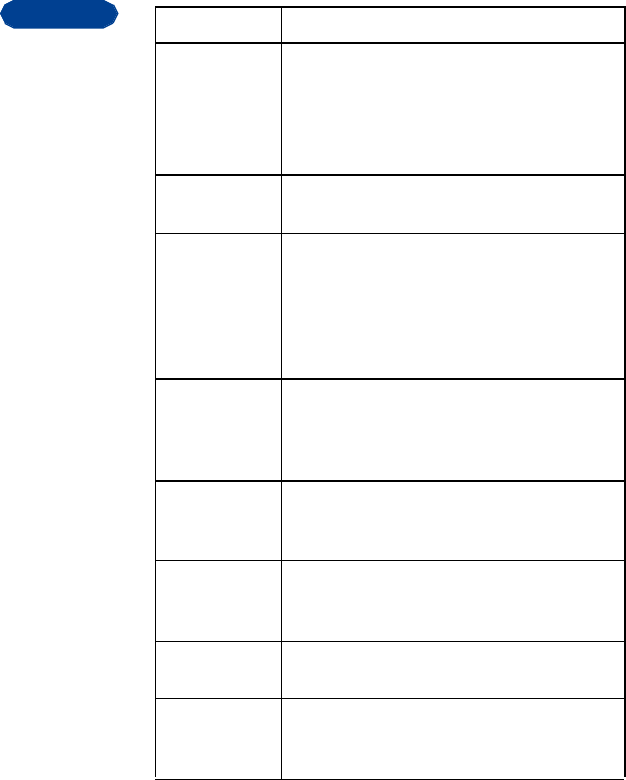
[ 112 ]
20
earpiece The portion of your phone that contains the
speaker. Used to play the audio portion of a
voice call as well
as any other audible tones (for example:
ringing, warning, etc.)
earpiece volume The sound level of the earpiece’s speaker during
a call.
E-mail Electronic Mail. A written form of
communication in which text (and other types
of information) is transmitted between
recipients electronically via special electronic
mail systems managed by corporations and/or
Internet service providers.
END key Used to terminate an active call or reject an
incoming call. Also used to return to the Start
screen from the phone book or from within the
phone’s menu.
ESN Electronic Serial Number. Used by wireless
service providers to identify your phone on the
wireless network.
fax call A call in which your Nokia phone functions as a
data/fax modem, connected to your PC via the
infrared port.
home system Refers to the wireless system to which you are
subscribed.
home type
system Refers to the same type of system to which you
are subscribed, but a system that is not your
primary home system.
Term Definition
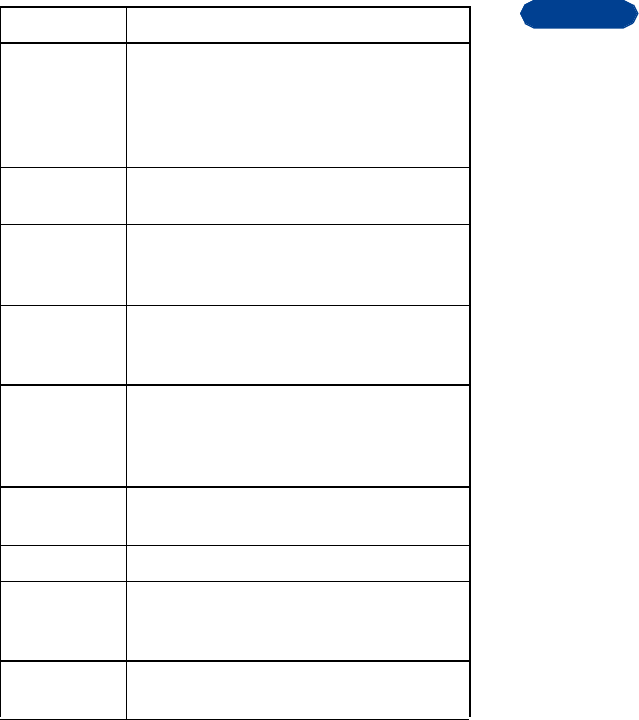
[ 113 ]
20
Internet An elaborate system of interconnected public
and private computer networks around the
world, used to provide access to information
and enable communication between users
worldwide.
keypad tones The sound heard when a key on your phone’s
keypad is pressed.
message alert
tone The sounds that are heard upon receipt of a text
or system message (e.g. call waiting
notification) by your phone.
microphone The electronic element in the base of your
phone that picks up your voice and other
sounds.
navigate A term that refers to the act of moving from
one Internet site or page to another, or to the
act of moving from one area of your phone’s
memory or menu to another.
non-home type
system Any system that does not use the same wireless
“format” as your home system.
number keys The numbered keys on your phone’s keypad.
power key A key on the front of the phone that allows you
to turn the phone on or off. This key can also be
used to recall and switch your phone’s profiles.
predictive text
input A system developed for rapid text entry using
your phone’s keypad.
Term Definition
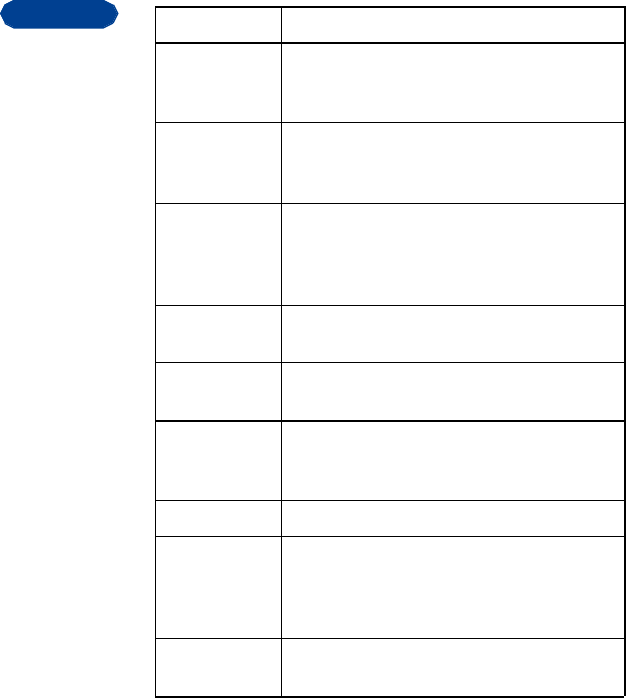
[ 114 ]
20
preferred
system Refers to a system that is the same “format” as
your home system, but is not the system to
which you have subscribed.
ringing option Refers to the way your phone plays (or if it
plays) a ringing tone when you have an
incoming call.
profile Refers to the various settings relating to your
phone’s audible, visible and vibrating alerts, and
the ability to have multiple configurations to
match your location or environment.
ringing tone The tone or melody that is heard when you have
an incoming call.
ringing volume Refers to the volume of your phone’s ringing
tone.
roaming The state of your phone when you are no longer
in your home system. Additional charges may
result.
screen Your phone’s display.
scroll To move through a list of names, menu items,
etc., press the up or down scroll key. Each new
selection or option is highlighted as you scroll
to it.
selection keys Refers to the keys under the lower left and
lower right corners of your phone’s screen.
Term Definition
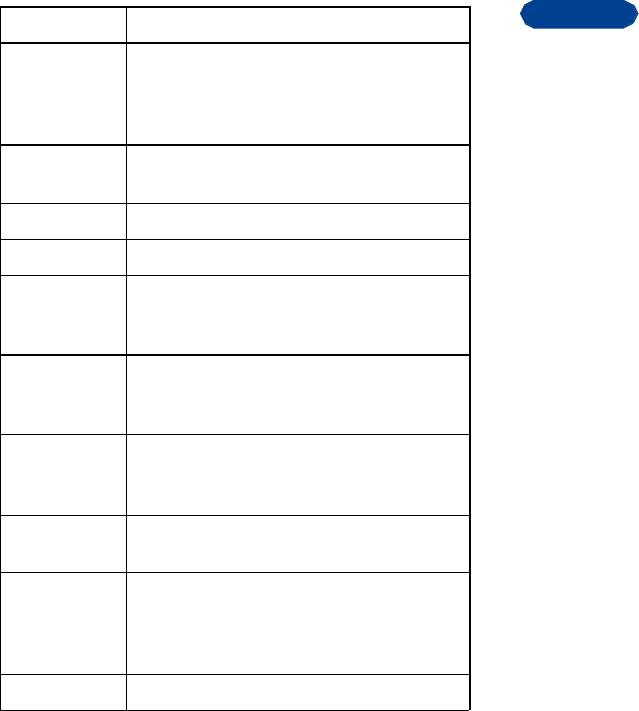
[ 115 ]
20
SMS Short Message Service. A service whereby you
can send and receive short text messages
(typically around 150 characters) with your
phone.
system Another way to refer to your wireless service
provider’s wireless network.
TALK key The key used to make or answer a call.
text message See SMS.
URL Universal Resource Locator. A URL is a Web
site’s specific address or location on the
Internet (for example: http://www.nokia.com).)
voice dialing The ability to dial numbers in your phone using
the phone’s voice recognition feature. (see
voice tags
voice mail A system maintained by your service provider,
used to record voice messages when you are
unable to answer a call.
voice mailbox The location on your service provider’s network
used to store voice mail messages.
voice tag A recording of a user’s voice that is assigned to
a phone book entry. Voice tag is used in
conjunction with voice dialing feature (see
voice dialing).
volume See earpiece volume or ringing volume.
Term Definition
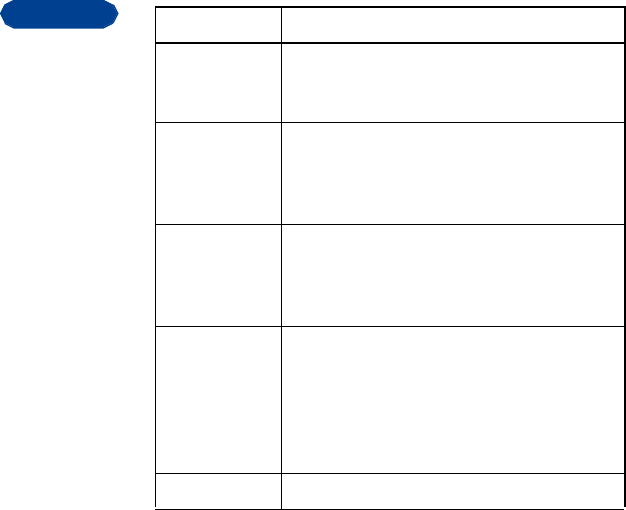
[ 116 ]
20
warning and
game tones The tone played when your phone displays a
warning, or those tones that are heard when
you are playing one of the phone’s games.
WAP Wireless Application Protocol. WAP is a new
section of the Internet designed to provide
information and services to you, and viewable
from your mobile phone’s screen.
wireless
network Your service provider’s operating environment,
including various types of hardware, software,
and landline connections, which makes wireless
calls possible.
World Wide
Web The part of the Internet that is viewed using a
special software application called a web
browser. The browser in your Nokia phone can
access many sites on the World Wide Web, as
well as sites designed specifically to be browsed
from a mobile phone (see WAP).
WWW See World Wide Web.
Term Definition

[ 117 ]
21
21 Reference information
• BATTERIES, CHARGERS, ACCESSORIES AND
TECHNICAL INFORMATION
This section provides information about the phone’s batteries, accessories,
chargers and technical information. Be aware that the information in this
section is subject to change as the batteries, chargers, and accessories
change.
This phone is intended for use when supplied with power from an ACP-7,
an ACP-8, ACP-9, LCH-8 or an LCH-9. Other usage could invalidate any
approval given to this apparatus and might be dangerous.
Warning: When you purchase batteries, chargers, and accessories for
your phone, use only batteries, chargers, and accessories that
have received approval from the phone’s manufacturer. The
use of any other type of phone-related hardware will
invalidate any approval or warranty applying to the phone,
and could also be dangerous. For availability of approved
batteries, chargers, and accessories, check with your dealer.
•When the battery is fully charged, the indicator will tell you that the
battery is fully charged.
•When you are not using a charger, disconnect it from the power
source. Do not leave the battery connected to a charger for more than
a week, since overcharging could shorten its lifespan. If left unused,
a fully charged battery will discharge itself over time.
Temperature extremes can affect the ability of your battery to charge.
Therefore, allow it to cool down or warm up before trying to charge it.
When the battery is running out of power and your phone only has a few
minutes of talk time remaining, a warning tone sounds and the Battery
low message appears briefly. When no more talk time is left, a warning
tone is sounded and the phone switches itself off.

[ 118 ]
21 Do not short-circuit the battery. Accidental short-circuiting can occur
when a metallic object, like a coin, a clip, or a pen causes a direct
connection of the + and - terminals of the battery, which are metal strips
on the back of the battery.
An example of short-circuiting could occur if you carry a spare battery in
your pocket or purse, where the battery could come into contact with
such objects like a coin. Short-circuiting could damage either the battery
or the connecting object.
Leaving the battery in hot or cold places, such as in a closed car in either
summer or winter conditions, will reduce the capacity and lifetime of
the battery. Always try to keep the battery between 15 C and 25 C
(59 F and 77 F).
A phone with a hot or cold battery might not work temporarily, even if the
battery is fully charged. The performance of Li-Ion batteries is particularly
limited in temperatures below 0 C (32 F).
The following list provides a guideline that you can follow:
•When the operating time (talk time and standby time) is noticeably
shorter than normal, buy a new battery.
•Use the battery only for its intended purpose.
•Never use any charger or battery that is damaged and/or worn out.
•Batteries must be recycled or disposed of properly. Do not dispose of
batteries by putting them in fire!
•When you disconnect the power cord of any accessory, grasp and pull
the plug, not the cord.
• IMPORTANT SAFETY INFORMATION
This section provides additional safety information. A brief overview of
safety can be found in “For your safety”.

[ 119 ]
21
Traffic safety
Do not use a hand-held telephone while driving a vehicle. Always park the
vehicle before using the phone.
After completing your phone conversation, always secure the phone back
into its holder; do not place the phone on the passenger seat or place it
where it can break loose in a collision or during a sudden stop.
Note: The use of an alert device to operate a vehicle’s lights or horn on
public roads is not permitted.
Remember: Safety—Your most important call.
Operating environment
Remember to follow any special regulations that are in force in any area,
and always switch off your phone wherever it is forbidden to use it.
Otherwise, the use of your phone could cause interference or danger.
When connecting the phone or any accessory to another device, read the
associated user guide first and obtain detailed safety instructions.
Note: Do not connect incompatible products.
As with other mobile radio transmitting equipment, you are advised that,
for the satisfactory operation of the equipment and for the safety of
personnel, it is recommended that the phone should only be used in the
normal operating position. This position is when the phone is held to your
ear with the antenna pointing over your shoulder.
Electronic devices
Most modern electronic equipment is shielded from radio frequency (RF)
signals. However, certain electronic equipment might not be shielded
against the RF signals from your wireless phone. The following four
subsections provide more information about this topic.
PACEMAKERS
Pacemaker manufacturers recommend that a minimum separation of six
inches (20 cm.) should be maintained between a handheld wireless phone
and a pacemaker to avoid potential interference with the pacemaker.

[ 120 ]
21 These recommendations are consistent with the independent research by
and recommendations of Wireless Technology Research. Persons with
pacemakers:
•should always keep the phone more than six inches (20 cm) from their
pacemaker when the phone is switched on
•should not carry the phone in a breast pocket
•should use the ear opposite the pacemaker to minimize the potential
for interference
Note: If you have any reason to suspect that interference is taking place,
switch off your phone immediately.
HEARING AIDS
Some digital wireless phones could interfere with some hearing aids. In
the event of such interference, you might want to consult your service
provider.
OTHER MEDICAL DEVICES
Operation of any radio transmitting equipment, including cellular phones,
could interfere with the functionality of inadequately protected medical
devices. Consult a physician or the manufacturer of the medical device to
determine if they are adequately shielded from external RF energy. Also
contact these authorities if you have any questions.
Switch off your phone in health care facilities or where any posted
regulations instruct you to do so. Hospitals or health care facilities could
be using equipment that is sensitive to external RF energy.
VEHICLES
RF signals could improperly affect installed or inadequately shielded
electronic systems in motor vehicles. These could include electronic fuel
injection systems, electronic anti-skid (anti-lock) braking systems,
electronic speed control systems, or air bag systems.
Check with the manufacturer or its representative regarding your vehicle.
You should also consult the manufacturer of any equipment that has been
added to your vehicle.

[ 121 ]
21
POSTED FACILITIES
Switch your phone off in any facility where posted notices so require.
Potentially explosive atmospheres
Switch off your phone if you are in any area that has a potentially
explosive atmosphere, and obey all signs and instructions. Sparks in such
areas could cause an explosion or fire, resulting in bodily injury or even
death.
You are advised to switch off the phone while at a refueling point (service
station). And, you are reminded of the need to observe restrictions
regarding the use of radio equipment in fuel depots (fuel storage and
distribution areas), chemical plants, or where blasting operations are in
progress.
Areas with a potentially explosive atmosphere are often—but not always—
clearly marked. These areas include the following: below deck on boats;
chemical transfer or storage facilities; vehicles using liquefied petroleum
gas (such as propane or butane); areas where the air contains chemicals
or particles, such as grain, dust or metal powders; and any other area
where you would normally be advised to turn off your vehicle engine.
Vehicles
Only qualified personnel should service the phone or install the phone in
a vehicle. Faulty installation or service could be dangerous and might
invalidate any warranty that could apply to the unit.
Regularly check that all wireless phone equipment in your vehicle is
mounted and operating properly.
Do not store or carry flammable liquids, gases or explosive materials in the
same compartment as the phone, its parts, or accessories.
For vehicles equipped with an air bag, remember that an air bag inflates
with great force. Do not place objects, including both the installed or the
portable wireless equipment, in the area over the air bag or in the air bag
deployment area. If the in-vehicle wireless equipment is improperly
installed and the air bag inflates, serious injury could result.

[ 122 ]
21 Switch off your phone before boarding an aircraft. The use of wireless
telephones in an aircraft may be dangerous to the operation of the
aircraft, disrupt the wireless telephone network and may be illegal.
Failure to observe these instructions could lead to the suspension or the
denial of telephone services to the offender, or it could result in legal
action, or both scenarios could apply.
• EMERGENCY CALLS
Important:
This phone, like any wireless phone, operates using radio signals, wireless
and landline networks, and user-programmed functions. Because of this,
connections in all conditions cannot be guaranteed. Therefore, you should
never rely solely on any wireless phone for essential communications (e.g.
medical emergencies).
Remember, to make or receive any calls, the phone must be switched on
and be used in a service area that has adequate signal strength.
Emergency calls might not be possible on all wireless phone networks or
when certain network services and/or phone features are in use. Check
with local service providers.
Always ensure that your phone is properly charged before attempting any
emergency calls. If you allow your battery to become empty, you will be
unable to receive or make calls, including emergency calls. You must then
wait a few minutes after the charging begins to place any emergency
calls.
Make an emergency call
1If the phone is not on, switch it on.
2Enter the emergency number for your present location (for example,
911 or any other official emergency number—emergency numbers
vary by location).
3Press [talk key] .

[ 123 ]
21
If certain features are in use (Keyguard, fixed dialing, restrict calls, and so
on), you might first need to turn those features off before you can make
an emergency call. Consult this guide and your local cellular service
provider.
When making an emergency call, remember to give all of the necessary
information as accurately as possible. Remember that your wireless phone
might be the only means of communication at the scene of an accident—
do not terminate the call until given permission to do so.
Radio frequency (RF) signals
THIS MODEL PHONE MEETS THE GOVERNMENT’S REQUIREMENTS FOR
EXPOSURE TO RADIO WAVES.
Your wireless phone is a radio transmitter and receiver. It is designed and
manufactured not to exceed the emission limits for exposure to
radiofrequency (RF) energy set by the Federal Communications
Commission of the U.S. Government. These limits are part of
comprehensive guidelines and establish permitted levels of RF energy for
the general population. The guidelines are based on standards that were
developed by independent scientific organizations through periodic and
thorough evaluation of scientific studies. The standards include a
substantial safety margin designed to assure the safety of all persons,
regardless of age and health.
The exposure standard for wireless mobile phones employs a unit of
measurement known as the Specific Absorption Rate, or SAR. The SAR
limit set by the FCC is 1.6W/kg.* Tests for SAR are conducted using
standard operating positions accepted by the FCC with the phone
transmitting at its highest certified power level in all tested frequency
bands. Although the SAR is determined at the highest certified power
level, the actual SAR level of the phone while operating can be well below
the maximum value. This is because the phone is designed to operate at
multiple power levels so as to use only the power required to reach the
network. In general, the closer you are to a wireless base station antenna,
the lower the power output.

[ 124 ]
21 Before a phone model is available for sale to the public, it must be tested
and certified to the FCC that it does not exceed the limit established by
the government-adopted requirement for safe exposure. The tests are
performed in positions and locations (e.g., at the ear and worn on the
body) as required by the FCC for each model. The highest SAR value for
this model phone as reported to the FCC when tested for use at the ear is
1.12 W/kg and when worn on the body, as described in this user guide, is
0.80 W/kg. (Body-worn measurements differ among phone models,
depending upon available accessories and FCC requirements.) While there
may be differences between the SAR levels of various phones and at
various positions, they all meet the government requirement.
The FCC has granted an Equipment Authorization for this model phone
with all reported SAR levels evaluated as in compliance with the FCC RF
exposure guidelines. SAR information on this model phone is on file with
the FCC and can be found under the Display Grant section of
http://www.fcc.gov/oet/fccid after searching on FCC ID LJP NPC-1NB.
For body worn operation, to maintain compliance with FCC RF exposure
guidelines, use only Nokia approved accessories. When carrying the phone
while it is on, place the phone in the carrying case (CBM-12) that has
been tested for compliance.
Use of non-Nokia-approved accessories may violate FCC RF exposure
guidelines and should be avoided.
*In the United States and Canada, the SAR limit for mobile phones used
by the public is 1.6 watts/kg (W/kg) averaged over one gram of tissue. The
standard incorporates a substantial margin of safety to give additional
protection for the public and to account for any variations in
measurements.
Care and maintenance
Your phone is a product of superior design and craftsmanship and should
be treated with care. The suggestions below will help you to fulfill any
warranty obligations and allow you to enjoy this product for many years.
When using your phone, battery, charger, or any accessory:

[ 125 ]
21
•Keep it and all its parts and accessories out of the reach of small
children.
•Keep it dry. Precipitation, humidity, and liquids contain minerals that
will corrode electronic circuits.
•Do not use or store it in dusty, dirty areas as its moving parts can be
damaged.
•Do not store it in hot areas. High temperatures can shorten the life of
electronic devices, damage batteries, and warp or melt certain
plastics.
•Do not store it in cold areas. When the phone warms up to its normal
operating temperature, moisture can form inside the phone, which
could damage the phone’s electronic circuit boards.
•Do not attempt to open it. Non-expert handling of the device could
damage it.
•Do not drop, knock or shake it. Rough handling can break internal
circuit boards.
•Do not use harsh chemicals, cleaning solvents, or strong detergents
to clean it. Wipe it with a soft cloth that has been slightly dampened
in a mild soap-and-water solution.
•Do not paint it. Paint can clog the device’s moving parts and prevent
proper operation.
•If the phone, battery, charger, or any accessory is not working
properly, take it to your nearest qualified service facility. The
personnel there will assist you, and if necessary, arrange for service.
• ACCESSORIES
If you want to enhance your phone’s functionality, a range of accessories
is available for you. You can select any of these items to help
accommodate your specific communication needs. For availability of
these and other accessories, contact your service provider.

[ 126 ]
21 A few practical rules for accessory operation
•Keep all accessories out of reach of small children.
•When you disconnect the power cord of any accessory, grasp and pull
the plug, not the cord.
•Check regularly that any vehicle-installed accessories are mounted
and are operating properly.
•Installation of any complex car accessories must be made by qualified
personnel only.
•Use only batteries, chargers, and accessories that have been approved
by the phone manufacturer. The use of any other types could
invalidate any approval or warranty applying to the phone, and could
be dangerous.
• BATTERIES
This section provides information about the phone’s batteries. Be aware
that the information in this section is subject to change.
Note: Dispose of used batteries in accordance with any local regulations.
The tables shown in this section provide information about battery
options that are available for your phone, charging times with the Rapid
Travel Charger (ACP-8), the Standard Travel Charger (ACP-7), talk times,
and standby times. Consult your service provider for more information.
Note: The charging times listed in the next section are approximate.
Charging times
Battery Option ACP-7 Charger ACP-8 Charger
BMC-2 640 mAh NiMH 2 hrs 45 min 1 hrs 30 min
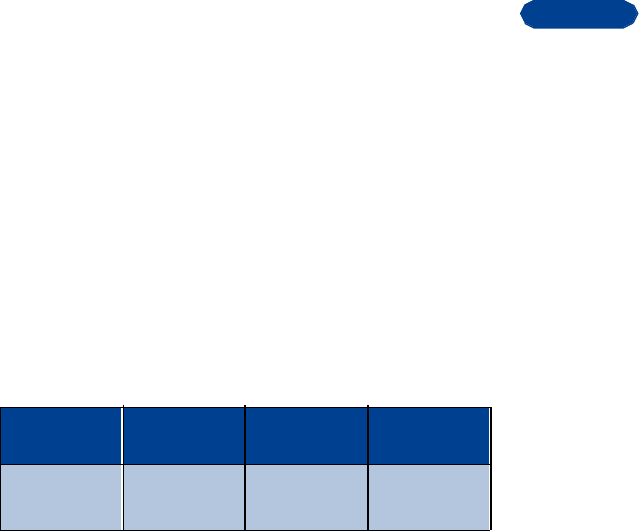
[ 127 ]
21
•The times displayed above allow your battery to obtain approximately
80% of its capacity. When this happens, the battery scroll bars on
your phone’s screen stop scrolling.
•If you want to obtain 100% battery capacity, allow another 2 hours
for a “trickle” or “maintenance” charge.
Standby and talk times
The times shown in the following table are approximate, and represent a
range for either standby or talk times (not a combination of both). Battery
operation times vary according to signal conditions, network parameters
set by the service provider, and how you use your phone.
Warning: Dispose of used batteries in accordance with any local
regulations.
Please refer to the following table for more information on talk and
standby times in both digital and analog networks.
• CHARGERS AND OTHER ACCESSORIES
This section provides information about the phone’s chargers and
accessories. Be aware that the information in this section is subject to
change as the chargers and accessories change.
The chargers and accessories that are described in this section are
available for your phone. Contact your dealer for details. Also, refer to the
accessories brochure that was included in your sales package for the
entire line of Nokia Original Accessories.
Battery Option Digital Talk
Time Analog Talk
Time Standby Time
BMC-2
640 mAh NiMH

[ 128 ]
21 When a charger is not in use
•When a charger is not in use, disconnect it from the power source.
•Do not leave the battery connected to a charger for longer than a
week, since overcharging the battery could shorten its lifespan. If left
unused, a fully charged battery will discharge itself over time.
Standard Travel Charger (ACP-7)
This is a lightweight (187g) <?> and durable AC charger.
•To use the Standard Travel Charger, plug it into a wall outlet and
connect the lead from the charger to the base of your phone.
[graphic]
Travel Charger (ACP-8)
This is a lightweight and durable AC charger. Calls can be made during
charging, even with a fully discharged battery.
•To use the Rapid Travel Charger (ACP-8), plug it into a standard 120V
or 220V AC wall outlet, and connect the lead from the charger to the
base of your phone.
The charger can also be used together with the optional Desktop Charging
Stand. Approximate charging times for discharged batteries are shown in
“Charging times” .
Rapid Cigarette Lighter Charger (LCH-9)
You can charge your phone’s battery from your vehicle battery by using
the Rapid Cigarette Lighter Charger (LCH-9). You can also use this
lightweight charger with the Desktop Charging Stand (DCV-10).
Calls are possible during charging. A green light indicates that the charger
is ready for charging (when not charging) or finished charging (if it has
been charging). The battery charging times are the same as those for the
Rapid Travel Charger (ACP-8).

[ 129 ]
21
The input voltage range is from 11 to 32V DC, negative grounding. Avoid
prolonged charging with the Rapid Cigarette Lighter Charger (LCH-9)
when the car engine is not running; this could cause your car battery to
drain. Note also, that in some cars, the cigarette lighter plug is not
provided with electricity if the ignition is not switched on.
Desktop Charging Stand (DCV-10)
Used together with the Standard Travel Charger (ACP-7), the Rapid Travel
Charger (ACP-8), or the performance Travel Charger (ACP-9) the Desktop
Charging Stand is an economical choice when you need your phone close
at hand, always ready for calls.
This charging stand allows you to charge your phone’s battery in an
upright, obtainable position on your desk.
•Charging is indicated by the scrolling battery bars that are located on
the right side of your phone’s Start screen.
•When the scrolling stops, the battery is approximately 80% charged.
The battery is fully charged a couple of hours after this time.
Headset (HDE-2)
[graphic of headset]
Nokia Xpress-on™ color covers
Your phone’s Xpress-on™ cover is available in several fashion colors. Extra
covers may be purchased from your authorized Nokia dealer.
Note: Always store the phone with cover attached.
CHANGING COVERS
1 Switch off the power and disconnect the phone from the charger or any
other device.
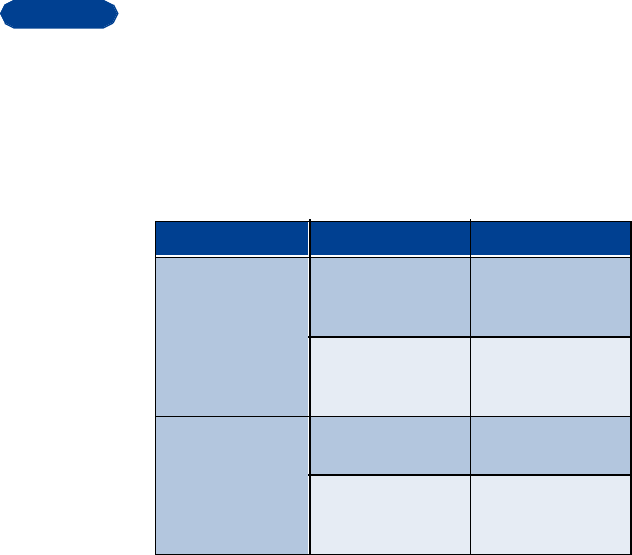
[ 130 ]
21
• TROUBLESHOOTING
This section provides a table that lists some of the most commonly-
encountered problems and provides possible solutions.
Problem Possible cause Possible solution
My phone isn’t
charging. The charger and the
phone are not
properly connected.
Securely connect the
charger to the phone.
The charger is not
properly plugged in. Ensure that the
charger is plugged in
correctly.
My phone isn’t
making/answering
calls.
The battery is not
charged. Charge the battery.
The signal strength is
poor. If you are indoors,
move toward a
window.
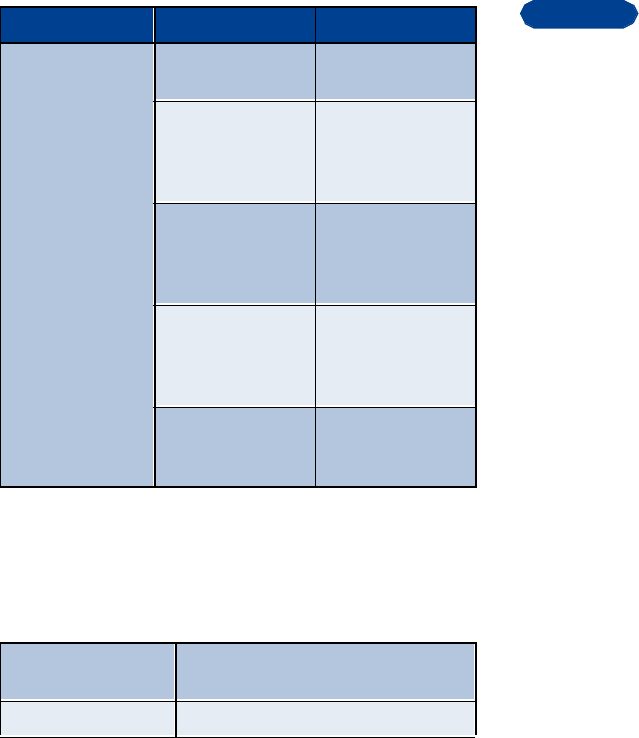
[ 131 ]
21
• TECHNICAL INFORMATION
I can’t listen to my
voice messages. You don’t have voice
mail service. Call your wireless
service provider.
You have not set up
your voice mailbox
with your service
provider.
Call your wireless
service provider.
You have not saved
your voice mail
number in your
phone.
Refer to “Set up your
voice mailbox”
You have forgotten
your password or are
entering it
incorrectly.
Call your wireless
service provider.
The voice mail
number you have
saved is incorrect.
Call your wireless
service provider.
Weight 137g (4.8 oz) with BMC-2 640 mAh
NiMH Battery
Size 105 cc
Problem Possible cause Possible solution
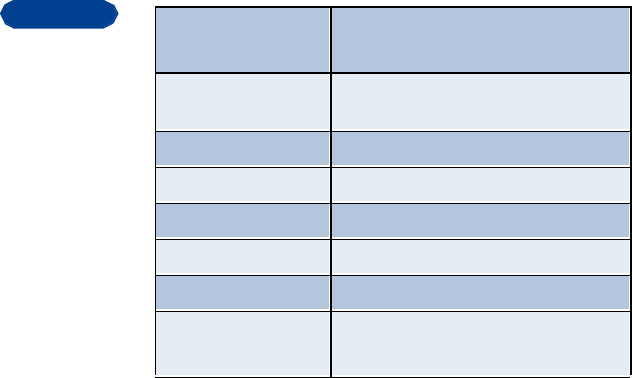
[ 132 ]
21 Frequency Range Lowband 824.04 - 848.97 MHz (TX)
869.04 - 893.97 MHz (TX)
Transmitter Output
Power Up to 600mW
Battery Voltage 3 V
Operating Temperature -4°F to + 104°F (-20°C to +40°C)
Number of Channels 832 lowband
Phone Numbers
Memory Locations 200
Memory Capacity Alpha:
Numeric:

[ 133 ]
22
22 NOKIA One-Year Limited
Warranty
Nokia Inc. (“Nokia”) warrants that this cellular phone (“Product”) is free
from defects in material and workmanship that result in Product failure
during normal usage, according to the following terms and conditions:
1The limited warranty for the Product extends for ONE (1) year
beginning on the date of the purchase of the Product.
2The limited warranty extends to the original purchaser of the Product
(“Consumer”) and is not assignable or transferable to any subsequent
purchaser/end-user.
3The limited warranty extends only to Consumers who purchase the
Product in the United States.
4During the limited warranty period, Nokia will repair, or replace, at
Nokia’s option, any defective parts, or any parts that will not properly
operate for their intended use with new or factory rebuilt
replacement items if such repair or replacement is needed because of
product malfunction or failure during normal usage. No charge will
be made to the Consumer for any such parts. Nokia will also pay for
the labor charges incurred by Nokia in repairing or replacing the
defective parts. The limited warranty does not cover defects in
appearance, cosmetic, decorative or structural items, including
framing, and any non-operative parts. Nokia’s limit of liability under
the limited warranty shall be the actual cash value of the Product at
the time the Consumer returns the Product for repair, determined by
the price paid by the Consumer for the Product less a reasonable
amount for usage. Nokia shall not be liable for any other losses or
damages. These remedies are the Consumer’s exclusive remedies for
breach of warranty.
5Upon request from Nokia, the Consumer must prove the date of the
original purchase of the Product by a dated bill of sale or dated

[ 134 ]
22 itemized receipt.
6The Consumer shall bear the cost of shipping the Product to Nokia in
Melbourne, Florida. Nokia shall bear the cost of shipping the Product
back to the Consumer after the completion of service under this
limited warranty.
7The Consumer shall have no coverage or benefits under this limited
warranty if any of the following conditions are applicable:
a) The Product has been subject to abnormal use, abnormal
conditions, improper storage, exposure to moisture or dampness,
unauthorized modifications, unauthorized connections,
unauthorized repair, misuse, neglect, abuse, accident, alteration,
improper installation, or other acts which are not the fault of
Nokia, including damage caused by shipping.
b) The Product has been damaged from external causes such as
collision with an object, or from fire, flooding, sand, dirt,
windstorm, lightning, earthquake or damage from exposure to
weather conditions, an Act of God, or battery leakage, theft,
blown fuse, or improper use of any electrical source, or damage
caused by the connection to other products not recommended for
interconnection by Nokia.
c) Nokia was not advised by the Consumer in writing of the alleged
defect or malfunction of the Product within fourteen (14) days
after the expiration of the applicable limited warranty period.
d) The Product serial number plate or the accessory data code has
been removed, defaced or altered.
e) The defect or damage was caused by the defective function of the
cellular system or by inadequate signal reception by the external
antenna.
8If a problem develops during the limited warranty period, the
Consumer shall take the following step-by-step procedure:
a) The Consumer shall return the Product to the place of purchase
for repair or replacement processing.

[ 135 ]
22
b) If “a” is not convenient because of distance (more than 50 miles)
or for other good cause, the Consumer shall ship the Product
prepaid and insured to:
Nokia Mobile Phones, Inc.
Attn: Repair Department
795 West Nasa Blvd.
Melbourne, FL. 32901
c) The Consumer shall include a return address, daytime phone
number and/or fax number, complete description of the problem,
proof of purchase and service agreement (if applicable). Expenses
related to removing the Product from an installation are not
covered under this limited warranty.
d) The Consumer will be billed for any parts or labor charges not
covered by this limited warranty. The Consumer will be
responsible for any expenses related to reinstallation of the
Product.
e) Nokia will repair or authorize the repair of the Product under the
limited warranty within 30 days after receipt of the Product by
Nokia or an Nokia authorized service center. If Nokia cannot
perform repair covered under this limited warranty within 30
days, or after a reasonable number of attempts to repair the same
defect, Nokia at its option, will provide a replacement Product or
refund the purchase price of the Product less a reasonable
amount for usage.
f) If the Product is returned to Nokia during the limited warranty
period, but the problem with the Product is not covered under the
terms and conditions of this limited warranty, the Consumer will
be notified and given an estimate of the charges the Consumer
must pay to have the Product repaired, with all shipping charges
billed to the Consumer. If the estimate is refused, the Product will
be returned freight collect. If the Product is returned to Nokia
after the expiration of the limited warranty period, Nokia’s

[ 136 ]
22 normal service policies shall apply and the Consumer will be
responsible for all shipping charges.
9The Product consists of newly assembled equipment that may contain
used components that have been reprocessed to allow machine
compliance with Product performance and reliability specifications.
10 ANY IMPLIED WARRANTY OF MERCHANTABILITY, OR FITNESS FOR A
PARTICULAR PURPOSE OR USE, SHALL BE LIMITED TO THE DURATION
OF THE FOREGOING LIMITED WRITTEN WARRANTY. OTHERWISE, THE
FOREGOING LIMITED WARRANTY IS THE CONSUMER’S SOLE AND
EXCLUSIVE REMEDY AND IS IN LIEU OF ALL OTHER WARRANTIES,
EXPRESS OR IMPLIED. NOKIA SHALL NOT BE LIABLE FOR SPECIAL,
INCIDENTAL OR CONSEQUENTIAL DAMAGES, INCLUDING BUT NOT
LIMITED TO, LOSS OF ANTICIPATED BENEFITS OR PROFITS, LOSS OF
SAVINGS OR REVENUE, PUNITIVE DAMAGES, LOSS OF USE OF THE
PRODUCT OR ANY ASSOCIATED EQUIPMENT, COST OF CAPITAL, COST
OF ANY SUBSTITUTE EQUIPMENT OR FACILITIES, DOWNTIME, THE
CLAIMS OF ANY THIRD PARTIES, INCLUDING CONSUMERS, AND
INJURY TO PROPERTY, RESULTING FROM THE PURCHASE OR USE OF
THE PRODUCT OR ARISING FROM BREACH OF THE WARRANTY,
BREACH OF CONTRACT, NEGLIGENCE, STRICT TORT, OR ANY OTHER
LEGAL OR EQUITABLE THEORY, EVEN IF NOKIA KNEW OF THE
LIKELIHOOD OF SUCH DAMAGES. NOKIA SHALL NOT BE LIABLE FOR
DELAY IN RENDERING SERVICE UNDER THE LIMITED WARRANTY, OR
LOSS OF USE DURING THE PERIOD THAT THE PRODUCT IS BEING
REPAIRED.
11 Some states do not allow limitation of how long an implied warranty
lasts, so the above one-year warranty limitation may not apply to you
(the Consumer). Some states do not allow the exclusion or limitation
of incidental and consequential damages, so certain of the above
limitations or exclusions may not apply to you (the Consumer). This
limited warranty gives the Consumer specific legal rights and the
Consumer may also have other rights which vary from state to state.
12 Nokia neither assumes nor authorizes any authorized service center

[ 137 ]
22
or any other person or entity to assume for it any other obligation or
liability beyond that which is expressly provided for in this limited
warranty including the provider or seller of any extended warranty or
service agreement.
13 This is the entire warranty between Nokia and the Consumer, and
supersedes all prior and contemporaneous agreements or
understandings, oral or written, and all communications relating to
the Product, and no representation, promise or condition not
contained herein shall modify these terms.
14 This limited warranty allocates the risk of failure of the Product
between the Consumer and Nokia. The allocation is recognized by the
Consumer and is reflected in the purchase price of the Product.
15 Any action or lawsuit for breach of warranty must be commenced
within eighteen (18) months following delivery of the Product.
16 Questions concerning this limited warranty may be directed to:
Nokia Customer Care Center
7725 Woodland Center Blvd., Ste. 150
Tampa, FL 33614
Telephone:1-888-NOKIA2U (1-888-665-4228)
Facsimile:1-813-249-9619
For the hearing impaired or other TTY users:
1-800-24NOKIA (1-800-246-6542)
17 The limited warranty period for Nokia supplied attachments and
accessories is specifically defined within their own warranty cards
and packaging.